AMD Zen 4 Ryzen 7000 Specs, Release Date, Benchmarks, Price Listings
The five fives: DDR5, PCIe 5.0, 5nm, AM5, and 5.7 GHz

As you can see in our Ryzen 9 7950X and Ryzen 5 7600X review, AMD has released its first four new Zen 4 Ryzen 7000 series "Raphael" processors. We've collected all of the most relevant performance benchmarks and info into this article to give you a broader view. The Zen 4 lineup touts the 16-core $699 Ryzen 9 7950X flagship, which AMD claims is the fastest CPU in the world, to the six-core $299 Ryzen 5 7600X, the lowest bar of entry to the first family of Zen 4 processors. According to our benchmarks, these chips deliver competitive performance, and that's a needed return to form.
AMD's previous-gen Ryzen 5000 processors accomplished what was once thought impossible: The chips unseated Intel's best in every CPU benchmark, including taking the top of our list of best CPUs for gaming, as the company outclassed Intel's Rocket Lake in every regard.
But then Alder Lake happened. Intel's new hybrid x86 architecture, featuring a blend of big and powerful cores mixed in with small efficiency cores, pushed the company into the lead in all facets of raw performance and even helped reduce its glaring deficiencies in the power consumption department. But, perhaps most importantly, Alder Lake started a full-on price war with Intel's new bare-knuckle approach to pricing, particularly in the mid-range that serves as gamer country.
| Row 0 - Cell 0 | Price | Cores / Threads (P+E) | Base / Boost Clock (GHz) | Cache (L2+L3) | TDP / Max | Memory |
| Ryzen 9 7950X | $699 | 16 / 32 | 4.5 / 5.7 | 80MB | 170W / 230W | DDR5-5200 |
| Ryzen 9 7900X | $549 | 12 / 24 | 4.7 / 5.6 | 76MB | 170W / 230W | DDR5-5200 |
| Ryzen 7 7700X | $399 | 8 / 16 | 4.5 / 5.4 | 40MB | 105W / 142W | DDR5-5200 |
| Ryzen 5 7600X | $299 | 6 / 12 | 4.7 / 5.3 | 38MB | 105W / 142W | DDR5-5200 |
But AMD isn't standing still, and its Ryzen 7000 chips have taken the race for performance leadership to the next level. Ryzen 7000's frequencies stretch up to 5.7 GHz - an impressive 800 MHz improvement over the prior generation – paired with an up to 13% improvement in IPC from the new Zen 4 microarchitecture. The chips also come loaded with new tech, like a new integrated Radeon RDNA 2 graphics engine and support AI instructions based on AVX-512.



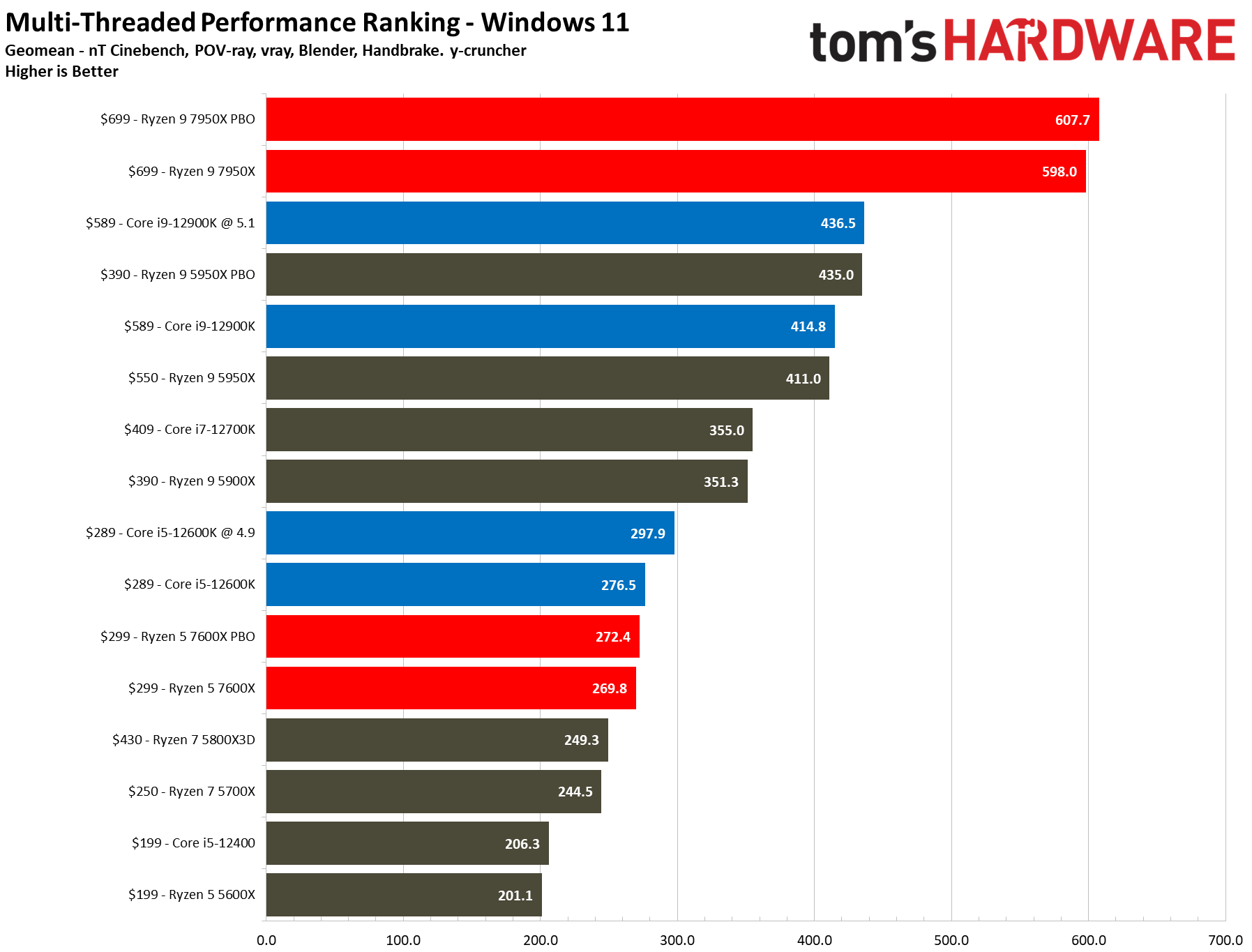


Here's a quick preview of how the Zen 4 chips stack up to Intel's Alder Lake, based on our own more extensive tests that you'll see below. Going head-to-head with Intel’s Core i9-12900K in 1080p gaming, the flagship Ryzen 9 7950X is 5% faster. In threaded applications, the 7950X is a whopping 44% faster than the Core i9-12900K, and the two chips effectively tie in single-threaded benchmarks.
The Zen 4 Ryzen 5 7600X is equally impressive, being 12% faster than the $289 Core i5-12600K in 1080p gaming, with the lead narrowing to 6% after overclocking both chips. More impressively, the stock 7600X is 4% faster than Intel’s flagship Core i9-12900K in gaming, bringing a new level of value to the $300 price point — with the caveat that you’ll have to deal with higher platform costs.
Both chips beat Intel’s flagship in gaming. However, as impressive as they are, they aren’t perfect: The Zen 4 Ryzen 7000 series has a high $300 entry-level price point and only supports pricey DDR5 memory instead of including less-expensive DDR4 options like Intel. That muddies the value proposition due to the expensive overall platform costs. AMD also dialed up power consumption drastically to boost performance, inevitably resulting in more heat and a more power-hungry system. You do end up with more performance-per-watt, though.
Ryzen 7000 takes the lead in convincing fashion, but its real competitor, Raptor Lake, doesn’t come until next month. Nevertheless, Intel claims its own impressive performance gains of 15% faster single-threaded, 41% faster threaded, and a 40% ‘overall’ performance gain, meaning we’ll see a close battle for desktop PC leadership.
The first four standard desktop PC chips are now available at retail, but the company will also launch at least one 3D V-Cache model by the end of the year. Intel has its Raptor Lake processors poised on the starting blocks, ensuring that AMD's Ryzen 7000 will have stiff competition when it arrives on October 20. We've gathered all of the information we know into this article.
AMD Zen 4 Ryzen 7000 Series at a Glance






- Codename Raphael, first four models launched on September 27
- Up to 16 cores and 32 threads on TSMC 5nm process (N5 used for compute die)
- 5.7 GHz peak clock speed
- Ryzen 9 7950X, Ryzen 9 7900X, Ryzen 7 7700X, and Ryzen 5 7600X at launch
- 6nm I/O die, DDR5 memory controllers, PCIe 5.0 interface
- DDR5 only (no DDR4 support), up to 125% more memory bandwidth per core
- RDNA 2 integrated GPU (present on IOD, very basic and low power)
- Zen 4 architecture has a 13% IPC gain
- AM5 Socket LGA 1718, backward compatible with AM4 coolers
- 600-Series Chipset: X670E Extreme, X670, B650E Extreme, and B650 Motherboards
- up to 170W TDP, 230W peak power
- Support for AVX-512, VNNI
- At least one 3D V-Cache Zen 4 model will come to market this year
AMD Zen 4 Ryzen 7000 Release Date
The first four Zen 4 Ryzen 7000 processors arrived on September 27, 2022, accompanied by the high-end X670 and X670E chipsets, while the B650E and the B650 chipsets will arrive in October. New EXPO (EXtended Profiles for Overclocking) DDR5 memory kits are also available, but PCIe 5.0 SSDs will come to market in October.
The Ryzen 7000 chips will mark just the first step of the Zen 4 journey as the company delivers on its CPU roadmap and brings them to the desktop and notebook markets. AMD will also use the Zen 4 architecture for its data center CPU roadmap.
AMD Zen 4 Ryzen 7000 Specifications and Features

The Ryzen 7000 processors come with the N5 TSMC 5nm process node for the core compute die (CCD) and use the TSMC 6nm process for the I/O Die (IOD). We have a deeper breakdown of the architecture further below. The chips will drop into Socket AM5 motherboards.
Get Tom's Hardware's best news and in-depth reviews, straight to your inbox.
| Row 0 - Cell 0 | Price | Cores / Threads (P+E) | Base / Boost Clock (GHz) | Cache (L2/L3) | TDP / PBP / MTP | Memory |
| Ryzen 9 7950X | $699 | 16 / 32 | 4.5 / 5.7 | 80MB (16+64) | 170W / 230W | DDR5-5200 |
| Ryzen 9 5950X | $546 ($799) | 16 / 32 | 3.4 / 4.9 | 74MB (8+64) | 105W | DDR4-3200 |
| Ryzen 9 7900X | $549 | 12 / 24 | 4.7 / 5.6 | 76MB (12+64) | 170W / 230W | DDR5-5200 |
| Ryzen 9 5900X | $398 ($549) | 12 / 24 | 3.7 / 4.8 | 70MB (6+64) | 105W | DDR4-3200 |
| Ryzen 7 7700X | $399 | 8 / 16 | 4.5 / 5.4 | 40MB (8+32) | 105W / ? | DDR5-5200 |
| Ryzen 7 5700X | $268 ($299) | 8 / 16 | 4.6 | 36 (4+32) | 105W | DDR4-3200 |
| Ryzen 5 7600X | $299 | 6 / 12 | 4.7 / 5.3 | 38MB (6+32) | 105W / ? | DDR5-5200 |
| Ryzen 7 5600X | $199 ($299) | 6 / 12 | 3.7 / 4.6 | 35MB (3+32) | 65W | DDR4-3200 |
Here's the generational comparison with both the current retail pricing for AMD’s Ryzen 5000 chips and the original launch pricing in parenthesis.
Overall, we see the same core counts as the previous-gen models but 16% to 17% higher clock rates across the new range of Ryzen 7000 SKUs. In addition, the chips all have more L2 cache but the same L3 cache capacity.
The 16-core 32-thread Ryzen 9 7950X is $100 less than the original launch pricing of the Ryzen 9 5950X, while the 12-core 24-thread Ryzen 9 7900X has the same launch pricing as its predecessor, the 5900X.
However, AMD raised the launch pricing of the eight-core 16-thread Ryzen 7 7700X by $100 over the 5700X. AMD also kept the entry-level pricing at the same $299 with the Ryzen 5 7600X, but that isn’t a complete win – this same high entry-level pricing wasn’t well-received with the Ryzen 5000 family. There's no mention of a Ryzen 7 7800X to replace the outgoing 5800X. Perhaps AMD is leaving a spot for its V-Cache-enabled X3D model here.
| Year / Processor | Peak Frequency | Frequency Gain | Process, Architecture |
| 2017 - Ryzen 7 1800X | 4.1 GHz | - | 14nm Zen 1 |
| 2018 - Ryzen 7 2700X | 4.3 GHz | +200 MHz / +5% | 12nm Zen+ |
| 2019 - Ryzen 9 3950X | 4.7 GHz | +400 MHz / +9% | 7nm Zen 2 |
| 2020 - Ryzen 9 5950X | 4.9 GHz | +200 MHz / +4% | 7nm Zen 3 |
| 2022 - Ryzen 9 7950X | 5.7 GHz | +800 MHz / +16% | 5nm Zen 4 |
As you can see, AMD has increased clock speeds across the breadth of its four new SKUs, a benefit of both the 5nm process and an architecture tuned for higher clock rates. For instance, the flagship Ryzen 9 7950X will have a 16% higher clock rate than the Ryzen 9 5950X, with its 5.7 GHz boost clock rate marking an incredible achievement for a 16-core chip — that's 800 MHz faster than its predecessor, setting a record as the largest frequency increase in the Ryzen era. The Ryzen 9 7900X is also impressive, with the 12-core chip also featuring an 800 MHz clock speed improvement.
As with all of AMD's latest chips, that will only occur on two cores: AMD has confirmed that Ryzen 7000 still features Precision Boost 2 to expose the maximum boost frequencies possible at all times. We also know that Intel's Raptor Lake will boost to 5.8 GHz, though, and perhaps higher.
AMD has also bumped up its TDP ratings, with a 65W increase in the base TDP for the Ryzen 9 models and a 45W increase for the Ryzen 5. The Ryzen 7 7700X doesn't see a TDP increase. Additionally, the peak power consumption (PPT) for the AM5 socket is now 230W. That's a significant increase over the previous-gen Ryzen 5000's 142W limit. We have a further breakdown of AMD's new TDP ranges in a section below.
AMD Zen 4 Ryzen 7000 vs Intel 13th-Gen Raptor Lake
| Row 0 - Cell 0 | Price | Cores / Threads (P+E) | P-Core Base / Boost Clock (GHz) | E-Core Base / Boost Clock (GHz) | Cache (L2/L3) | TDP / PBP / MTP | Memory |
| Core i9-13900K / KF | $589 (K) - $564 (KF) | 24 / 32 (8+16) | 3.0 / 5.8 | 2.2 / 4.3 | 68MB (32+36) | 125W / 253W | DDR4-3200 / DDR5-5600 |
| Ryzen 9 7950X | $699 | 16 / 32 | 4.5 / 5.7 | - | 80MB (16+64) | 170W / 230W | DDR5-5200 |
| Core i9-12900K / KF | $589 (K) - $564 (KF) | 16 / 24 (8+8) | 3.2 / 5.2 | 2.4 / 3.9 | 44MB (14+30) | 125W / 241W | DDR4-3200 / DDR5-4800 |
| Ryzen 9 7900X | $549 | 12 / 24 | 4.7 / 5.6 | - | 76MB (12+64) | 170W / 230W | DDR5-5200 |
| Core i7-13700K / KF | $409 (K) - $384 (KF) | 16 / 24 (8+8) | 3.4 / 5.4 | 2.5 / 4.2 | 54MB (24+30) | 125W / 253W | DDR4-3200 / DDR5-5600 |
| Core i7-12700K / KF | $409 (K) - $384 (KF) | 12 / 20 (8+4) | 3.6 / 5.0 | 2.7 / 3.8 | 37MB (12+25) | 125W / 190W | DDR4-3200 / DDR5-4800 |
| Ryzen 7 7700X | $399 | 8 / 16 | 4.5 / 5.4 | - | 40MB (8+32) | 105W / 142W | DDR5-5200 |
| Ryzen 5 7600X | $299 | 6 / 12 | 4.7 / 5.3 | - | 38MB (6+32) | 105W / 142W | DDR5-5200 |
| Core i5-13600K / KF | $319 (K) - $294 (KF) | 14 / 20 (6+8) | 3.5 / 5.1 | 2.6 / 3.9 | 44MB (20+24) | 125W / 181W | DDR4-3200 / DDR5-5600 |
| Core i5-12600K / KF | $289 (K) - $264 (KF) | 10 / 16 (6+4) | 3.7 / 4.9 | 2.8 / 3.6 | 29.5MB (9.5+20) | 125W / 150W | DDR4-3200 / DDR5-4800 |
| Core i5-13400 / F | ? | 10 / 16 (6+4) | 3.4 / ? | ? | 24MB | 65W / ? | DDR4-3200 / DDR5-5600 |
| Core i5-12400 / F | $199 - $167 (F) | 6 / 12 (4+0) | 4.4 / 2.5 | - | 25.5MB (7.5+18) | 65W / 117W | DDR4-3200 / DDR5-4800 |
This is how Ryzen 7000 stacks up against Intel’s existing Alder Lake chips, along with information that we’ve collected about Intel’s yet-to-be-announced Raptor Lake. Be aware that the Raptor Lake specifications in the above table are not yet official.
Intel’s Alder Lake Core i9-12900K is faster in most workloads than the current Ryzen flagship, but its next-gen 13900K adds in eight more E-Cores, which will deliver substantially more performance in heavily-threaded workloads. Intel has also sprinkled in four more e-cores for its 13700K and 13600K.
Intel has also brought E-cores to its value-centric 13400 SKU for the first time, which will make for a significantly more competitive chip on the lower end of the market where AMD isn't nearly as competitive. Again, pricing and performance are the wild cards, and Intel has yet to make any official announcements. However, it is clear that Intel will use a combination of higher clock speeds and more E-Cores to combat Ryzen 7000.
In many respects, this generation of chips finds the Zen 4 vs Intel Raptor Lake competition returning to an outright frequency war, with both chipmakers pushing their consumer chips to the highest clocks we've seen with their modern offerings. That also brings higher power consumption, and we also see higher TDP figures from both chipmakers as they turn up the frequency dial. Naturally, higher peak power figures will be more useful in threaded workloads, so we can expect more from each core with the Zen 4 processors.
AMD's Zen 4 Ryzen 7000 chips only support DDR5 memory, while Raptor Lake supports DDR4 and DDR5. That gives Intel a leg up in the overall system cost category, as DDR5 still commands a price premium. However, we no longer see DDR5 shortages, and prices continue to plummet as more supply comes online and demand recedes.
The Zen 4 Ryzen 7000 chips seem to have exceptional overclocking headroom, at least according to several early tests made available to the public. We've seen the flagship Ryzen 9 7950X set four world records with standard liquid cooling, beating out liquid nitrogen-cooled chips. If you want to go subzero, the chips also appear to have exceptional headroom when you go sub-ambient, with the chips hitting 7.2 GHz on a single core and 6.5 GHz on all cores with LN2.






AMD shared a block diagram of the standard Ryzen 7000 chip, and we took a close-up snip of a bare Ryzen 7000 chip during the company's Computex keynote. The chip houses two gold-colored 5nm core chiplets, each sporting eight cores. AMD says these are based on an optimized version of TSMC's high-performance 5nm process technology called N5, and they are placed much closer together than we've seen with previous Ryzen core chiplets. In addition, we see what appears to be a shim between the two core chiplets, likely to maintain an even surface atop the two dies. It is also possible that this close orientation is due to some type of advanced packaging interconnect between the two chips.
We can also see a clear outline around the top of each CCD, but we aren't sure if this is from a new metallization technique. We do know that the gold color is due to Backside Metallization (BSM), which includes an Au coating to prevent oxidation while improving TIM adhesion and lowering thermal impedance. We also see quite a few empty spots for capacitors, which is interesting and could imply heftier designs down the road.
The new I/O die uses the 6nm process and houses the PCIe 5.0 and DDR5 memory controllers along with a much-needed addition for AMD — the RDNA 2 graphics engine. The new 6nm I/O die also has a low-power architecture based on features pulled in from AMD's Ryzen 6000 chips, so it has enhanced low power management features and an expanded palette of low-power states. AMD says this chip now consumes around 20W, which is less than it did with Ryzen 5000, and will deliver the majority of the power savings we see in Ryzen 7000.
Surprisingly, the new I/O die appears to be roughly the same size as the previous-gen 12nm I/O die. However, given that the 6nm die is far denser than the 12nm die from GlobalFoundries, meaning it has far more transistors, it's safe to assume the integrated GPU has consumed a significant portion of the transistor budget (possibly due in part to onboard iGPU cache). The large 6nm I/O die will inevitably add to the cost of the chips, as it will be far more expensive than the mature 12nm I/O die that AMD used in the Ryzen 5000 chips.
AMD has officially confirmed that the Ryzen 7000 series chips will come with at least one model armed with the company's 3D V-Cache this year, enabling incredible L3 cache capacity through its innovative 3D-stacked SRAM tech that fuses an L3 chiplet on top of the compute cores. We've seen this technology give the Ryzen 7 5800X3D a total of 96MB of L3 cache, providing it with industry-leading gaming performance. We might have already seen signs of this — memory maker TeamGroup recently mentioned the Raphael-X processors in a press release. AMD hasn't divulged 'Raphael-X' as the official name of the 3D V-Cache Ryzen 7000 chips, but it does follow the same naming convention as the Milan-X server chips that have the same tech. It's certainly possible this is merely a mistake on TeamGroup's part, but speculation is intense that this will be the codename for the consumer Zen 4 3D V-Cache chips.
The stock memory frequencies for Ryzen 7000 weigh in at DDR5-5200, though the company has touted that it expects to have exceptional DDR5 overclockability. The new AMD EXPO (EXtended Profiles for Overclocking) tech is an alternative to Intel's XMP branding. Simply put, AMD will support pre-defined memory profiles with dialed-in memory frequencies, timings, and voltages to enable one-click memory overclocks. Several reports indicate that AMD will have 'high-bandwidth' and 'low-latency' EXPO profiles, which would likely denote the difference between coupled (1:1) and uncoupled (1:2) modes, just like Intel's Gear 1 and Gear 2 memory modes. That's a positive development, and it appears that you'll be able to dial in higher 1:1 memory overclocks — new BIOS revisions have support for a 3GHz fabric frequency, whereas that mostly topped out at 2 GHz with Ryzen 5000. However, these could just be pre-assigned settings that aren't attainable, so we'll have to wait for the chips to hit our labs.
AMD has said that DDR5-5600 memory is the 'sweet spot' for the Zen 4 Ryzen 7000 chips. We've seen several new kits, like TeamGroup's Vulcana modules, that are tuned for this speed.
The Ryzen 7000 chips support up to 24 lanes of the PCIe 5.0 interface directly from the socket (further details in the motherboard section). AMD is busy enabling the PCIe 5.0 SSD ecosystem with Phison, Micron, and Crucial. Crucial and Micron will have their first PCIe 5.0 SSDs and the constellation of third-party SSDs will also use Phison's E26 PCIe 5.0 SSD controllers, meaning we'll soon see wide availability of even speedier drives. That will come in handy for Zen 4 Ryzen 7000 systems — AMD claims a 60% performance gain in sequential read workloads with PCIe 5.0 SSDs. The first PCIe 5.0 SSDs come to market in October.
PCIe 5.0's sequential performance potential will be great for Microsoft's DirectStorage because it relies heavily upon read throughput to reduce game loading times to roughly a second. AMD also says Ryzen 7000 will support Smart Access Storage (SAS), which appears to be a slightly tweaked version of DirectStorage that's built on the same APIs. You can see more information about AMD's PCIe 5.0 SSD enablement here. Unfortunately, not all of the leading-edge PCIe 5.0 SSDs will fully utilize the bandwidth of the faster interface — Micron's leading-edge flash doesn't operate at full speed, constraining SSD performance, but that will be rectified early next year. We expect even faster models to arrive then.
On the security front, AMD's Ryzen 6000 'Rembrandt' processors arrived with support for Microsoft's Pluton, enabling more robust security to helps prevent physical attacks and encryption key theft while protecting against firmware attacks. Pluton originally debuted in the Xbox and AMD's EPYC data center processors and is complementary to AMD’s other security features, like AMD Secure Processor and Memory Guard, among others. AMD hasn't officially confirmed that Pluton is present in Ryzen 7000, but it is expected.
The Ryzen 7000 processors come with expanded instructions for AI acceleration through its support of AVX-512 instructions, which can be used for functions like VNNI for neural networks and BFLOAT16 for inference. AMD described its AVX-512 implementation as a 'double-pumped' execution of 256-bit wide instructions to defray the frequency penalties typically associated with Intel's processors when they execute AVX-512 workloads. This could result in lower throughput per clock than Intel's method, but the higher clocks will obviously offset at least some of the penalty. We'll have to wait to learn more about the new implementation.
That oddly places Intel's Alder and Raptor Lake chips at a disadvantage as they have disabled AVX-512 functionality due to the hybrid architecture. Software vendors are already preparing for the new functionality — benchmarking and monitoring tool AIDA64 recently added support for AVX-512 with Zen 4 processors, followed by y-cruncher support.
AMD Zen 4 Ryzen 7000 Integrated Graphics
All Ryzen 7000 chips will support some form of graphics, so it doesn't appear there will be graphics-less options, like Intel's F-series, for now. The RDNA 2 engine resides on the IOD (I/O Die) and supports up to four display outputs, including DisplayPort 2 and HDMI 2.1 ports, and Ryzen 7000 has the same video (VCN) and display (DCN) engine as the Ryzen 6000 'Rembrandt" processors. Even though all Ryzen 7000 chips will have baked-in iGPUs, the company will still release Zen 4 APUs with beefier iGPUs. The company will also bring its Smart Shift ECO tech, which allows shifting the graphical work between the iGPU and a discrete GPU to save power, to the Ryzen 7000 models for the desktop PC.



AMD has tried to temper expectations for the integrated graphics engine, pointing out that the RDNA 2 graphics are only designed to 'light up' displays, cautioning that we shouldn't expect any meaningful gaming performance. The RDNA 2 iGPU comes with two compute units, 4 ACE, and 1 HWS, so that should be pretty apparent.







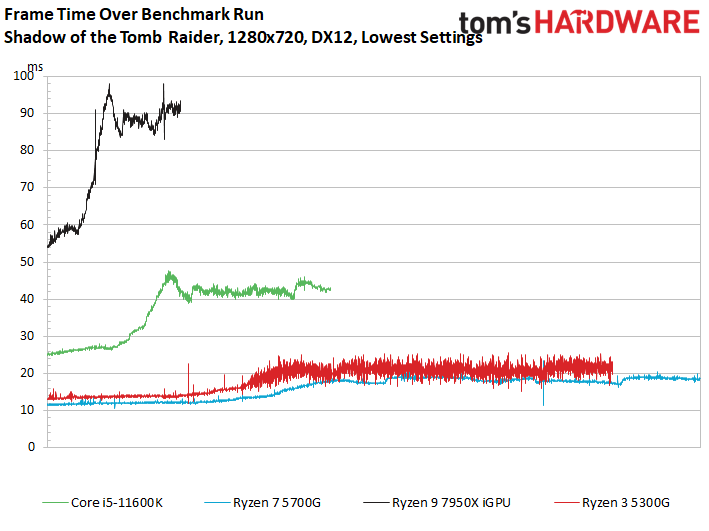

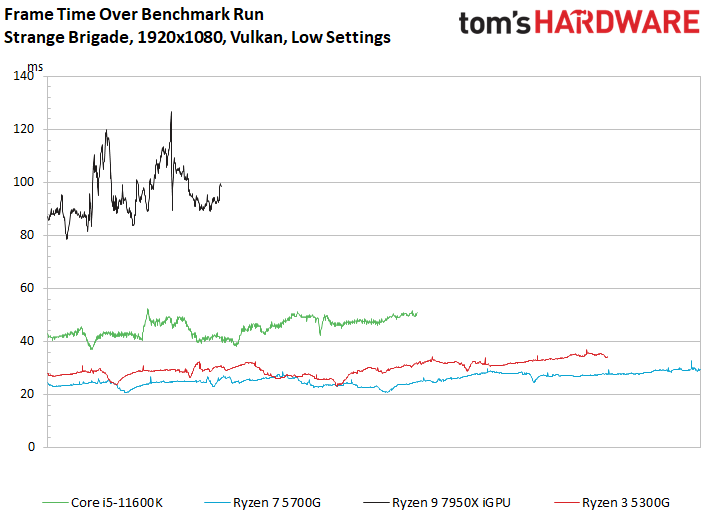
We tried a few games anyway, which you can see if you flip through the album above, and the results weren’t pretty. We couldn’t get Far Cry 6 to load, for instance, and Shadow of the Tomb Raider could render the benchmark at 1280x720 but wouldn’t run at 1080p. Much like Intel’s graphics, we were treated to a slideshow in the few games that did run. The bar charts don't do the poor results enough justice -- check out the frametime over time charts for perspective on just how badly the iGPU performs in gaming.
The integrated graphics do have appeal for troubleshooting and OEM systems, though, and it has a few other redeeming qualities. The iGPU supports AV1 and VP9 decode, H.264 and HVEC encode and decode, USB Type-C with DisplayPort Alt Mode, DisplayPort 2.0 (adaptive sync, DSC, UHBR10, HDR), and HDMI 2.1 (HFR, 48Gbps FRL, DSC, HDR10+, and VRR). You also get support for 4K60 and hybrid graphics.
AMD Zen 4 Ryzen 7000 Benchmarks and Zen 4 IPC
Below you can see the geometric mean of our gaming tests at 1080p and 1440p, with each resolution split into its own chart. Be aware that a different mix of game titles could yield somewhat different results (particularly with the Ryzen 7 5800X3D), but this serves as a solid overall indicator of gaming performance. As usual, we're testing with an Nvidia GeForce RTX 3090 to reduce GPU-imposed bottlenecks as much as possible, and differences between test subjects will shrink with lesser cards or higher resolutions. You'll find further game-by-game breakdowns below.

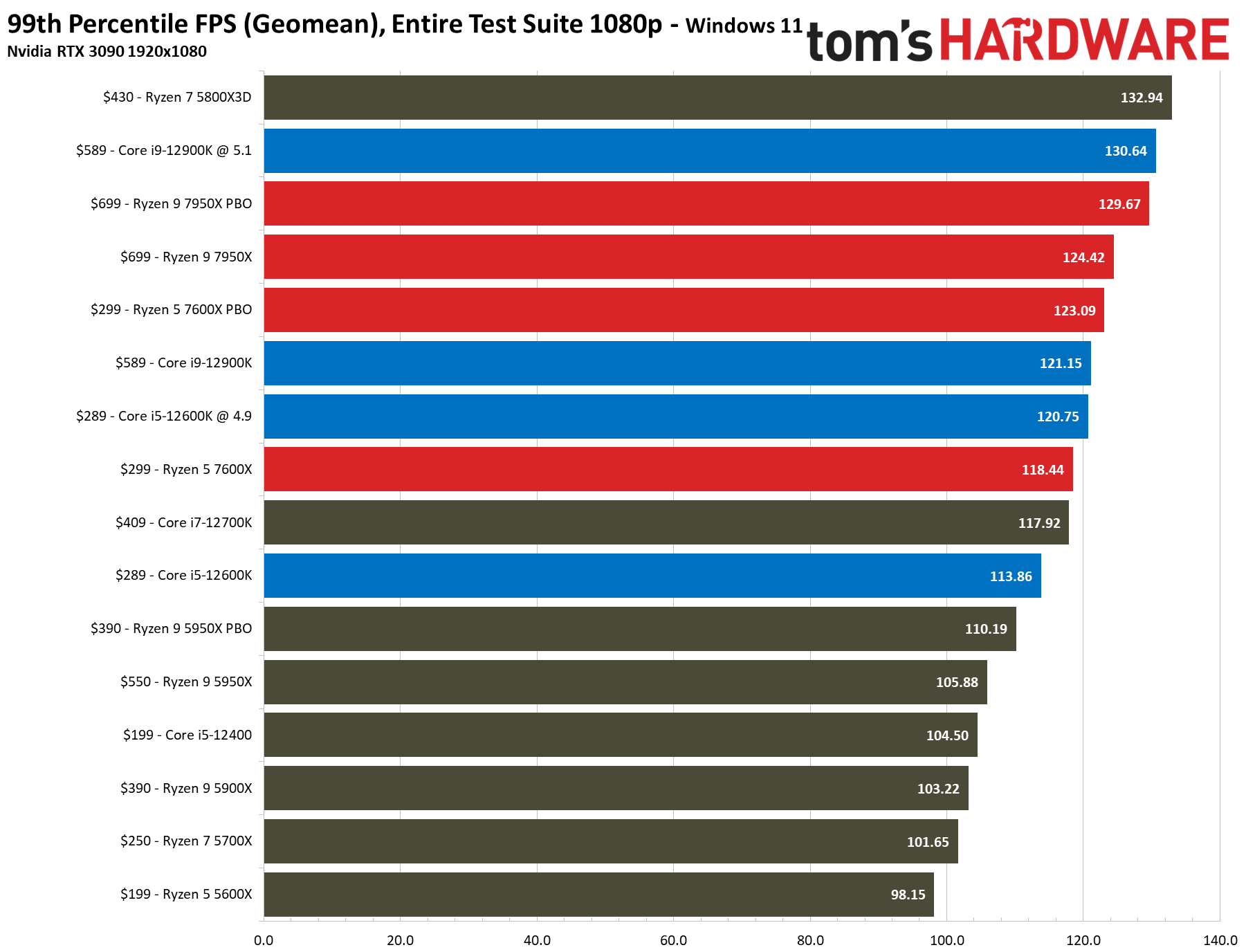





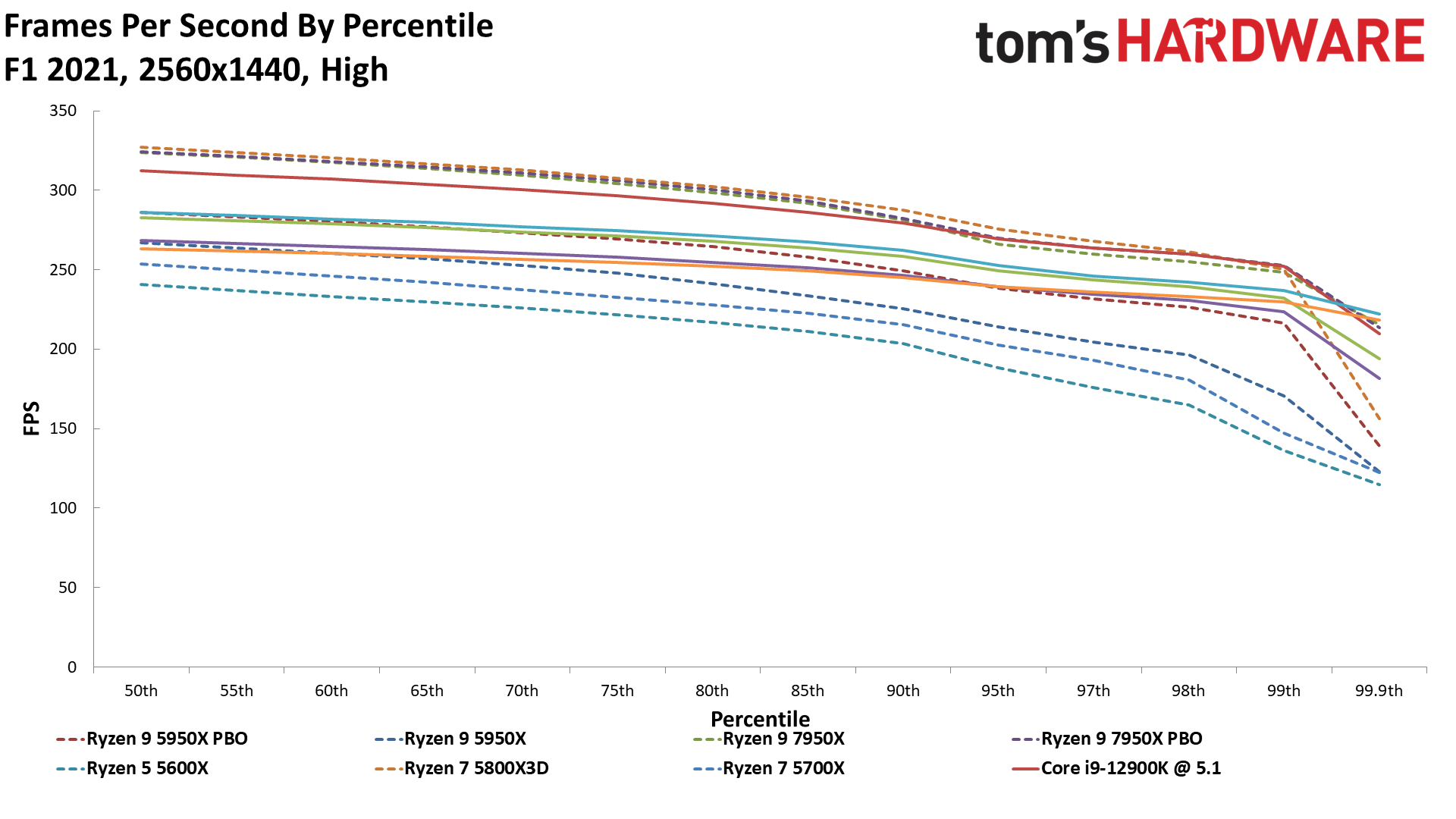







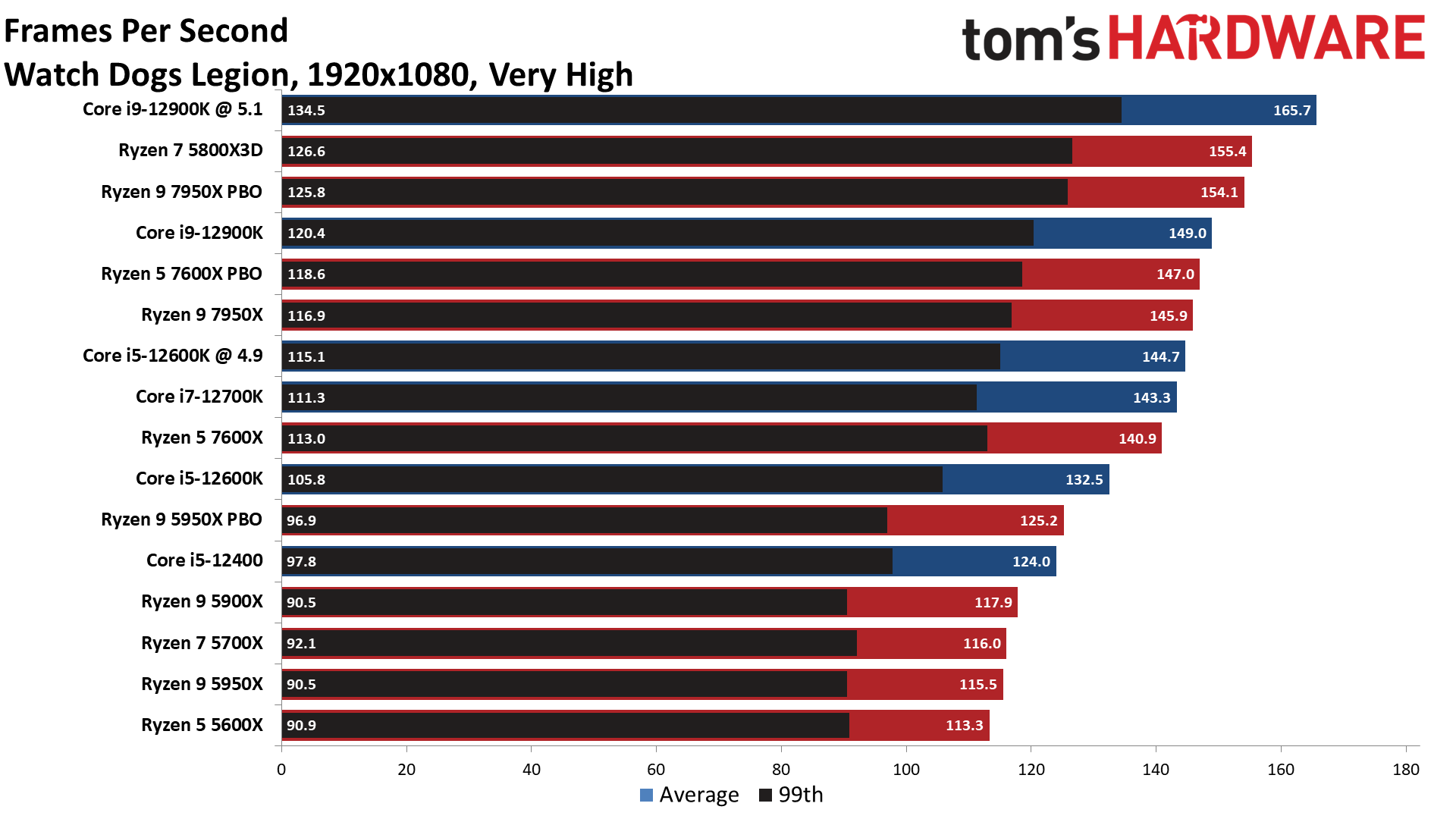


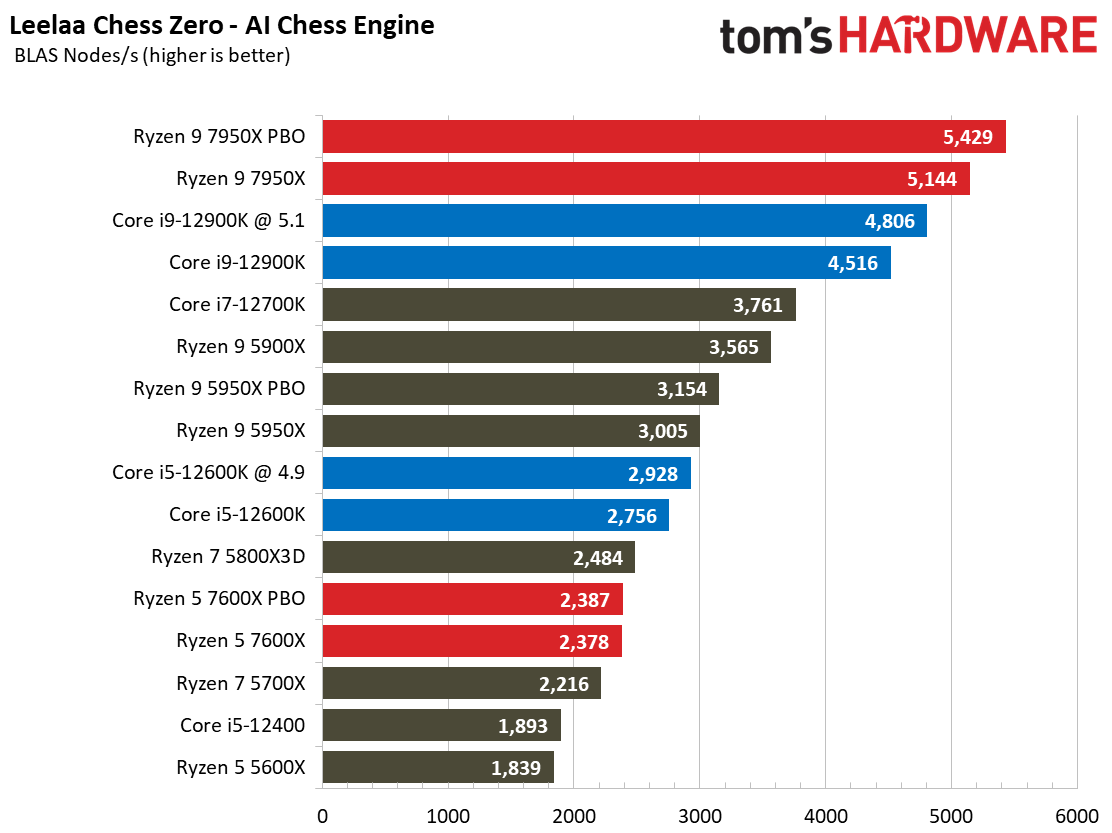
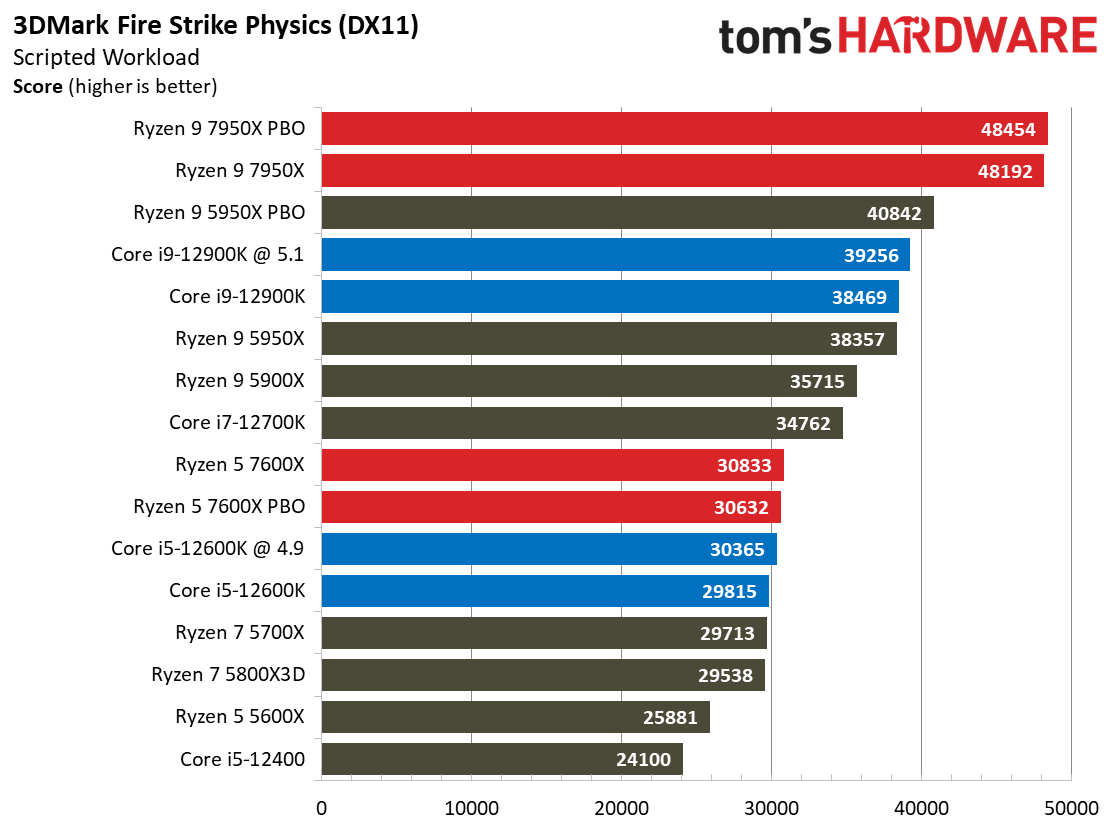

The $699 Ryzen 9 7950X takes second place in its stock configuration with a 5% lead over Intel’s fastest gaming chip, the Core i9-12900K. The 7950X is another ~2% faster after overclocking the cores and memory, essentially tying the overclocked 12900K. This marks a big generational improvement — the Ryzen 9 7950X is 17% faster than its prior-gen counterpart, the Zen 3-powered Ryzen 9 5950X, which also comes with 16 cores. However, Intel only needs to gain ~5% with Raptor Lake to match the 7950X in gaming, setting the stage for quite the competition next month.
The $299 Ryzen 5 7600X is 12% faster than the $289 Core i5-12600K, with the lead narrowing to 6% after overclocking both chips. More impressively, the stock 7600X is 4% faster than Intel’s flagship Core i9-12900K, bringing a new level of value to the $300 price point — with the caveat that you’ll have to deal with higher platform costs.
Notably, the 12900K is ~7% faster than the 7600X in our 1080p 99th percentile measurements, a good indicator of smoothness. The 7600X’s lead over the 12600K also drops to ~4%. However, we don’t see any egregious outliers in the 99th percentile measurements that would significantly alter our overall impressions of the rankings you see in the average fps chart.
The Ryzen 5 7600X also sports a big generational uplift of 18% over the Ryzen 5 5600X, which was once the darling of mid-range gaming builds. Raptor Lake looks enticing in the mid- and low-end price ranges from afar, but the 7600X will go a long way to shoring up AMD’s defenses. You can also tune the 7600X and eke out an extra ~3% of performance, but as always, gains will vary by title and by the quality of your chip.
The $300 Ryzen 5 7600X represents the entry-level for Zen 4, at least for now, but the Ryzen 9 7950X costs more than twice as much and is only 2% faster in gaming. That means the 76000X is an exceptional value for gaming, and as per usual with Ryzen 9 chips, the 7950X is really for those who need prosumer-class performance in applications.
AMD’s own $430 Ryzen 7 5800X3D remains the fastest gaming chip on the market by a fair margin, but this highly-specialized chip comes with caveats — its 3D V-Cache doesn't boost performance in all games. Additionally, the 5800X3D is optimized specifically for gaming, but it can't keep pace with similarly-priced chips in productivity applications. AMD will bring at least one Zen 4-powered Ryzen 7000 processor with 3D V-cache to market this year, so you might want to consider waiting a few more months if you’re after a specialized gaming chip of this ilk.
Naturally, the differences between the chips shrink when we switch over to 1440p and bring a GPU bottleneck into play, but the story remains largely similar, with scant differences between the chips at the top of the leaderboard. The competition between Intel and AMD is even closer now, so it's best to make an informed decision based on the types of titles you play frequently.


It should come as no surprise that the Ryzen 9 7950X absolutely dominates our cumulative measurement of multi-threaded performance, but the delta is impressive nonetheless. The 7950X is a whopping 44% faster than the Core i9-12900K, and overclocking does little to close the gulf between the chips. The 7950X is also 45% faster than the 5950X, living up to AMD’s performance claims.
For perspective, the beastly $3,299 Threadripper Pro 32-core Ryzen 9 5975WX is only 17% faster than the 7950X in this same cumulative measurement. However, it costs 5 times more, highlighting just how exceptional this amount of threaded horsepower is on a mainstream PC platform. This probably has something to do with AMD’s decision not to bring a Zen 3-powered HEDT platform to market.
That’s a tough act for the 7600X to follow, especially given that the Core i5-12600K is a few percentage points faster in threaded work. That comes on the strength of the 12600K’s e-cores, and overclocking extends the 12600K’s lead to 10%. In either case, the Ryzen 5 7600X still marks a solid generational improvement for Ryzen, as it is 34% faster than the prior-gen Ryzen 5 5600X.
Intel’s Alder Lake took a pronounced lead in single-threaded performance over the prior-gen Ryzen 5000 processors, but the Zen 4 architecture takes a big step forward, slightly edging out the price-comparable Alder Lake chips. In our cumulative measurement of single-threaded performance, the Ryzen 9 7950X and 7600X effectively tie the Core i9-12900K and 12600K, respectively, leveling the playing field.
You’ll notice that the overclocked configurations offer little to no benefit for the Ryzen processors, as expected, while both Intel processors actually lose some performance in this metric. It isn’t surprising to see the 12900K lose a tad — the all-core 5.1 GHz overclock is lower than its peak 5.2 GHz boosts on a single core — but the 12600K’s decline is a bit unexpected because the overclock matches its peak clock rate. After quite a bit of analysis and repeated testing, it appears that thread targeting isn’t working as effectively with the overclocked Intel configurations, resulting in quite a bit of thread migration during single-threaded tasks. We’re still troubleshooting this issue, but the results are repeatable so we’re including them.
You can find the benchmarks we used to generate these cumulative measurements in our Ryzen 9 7950X and Ryzen 5 7600X review.



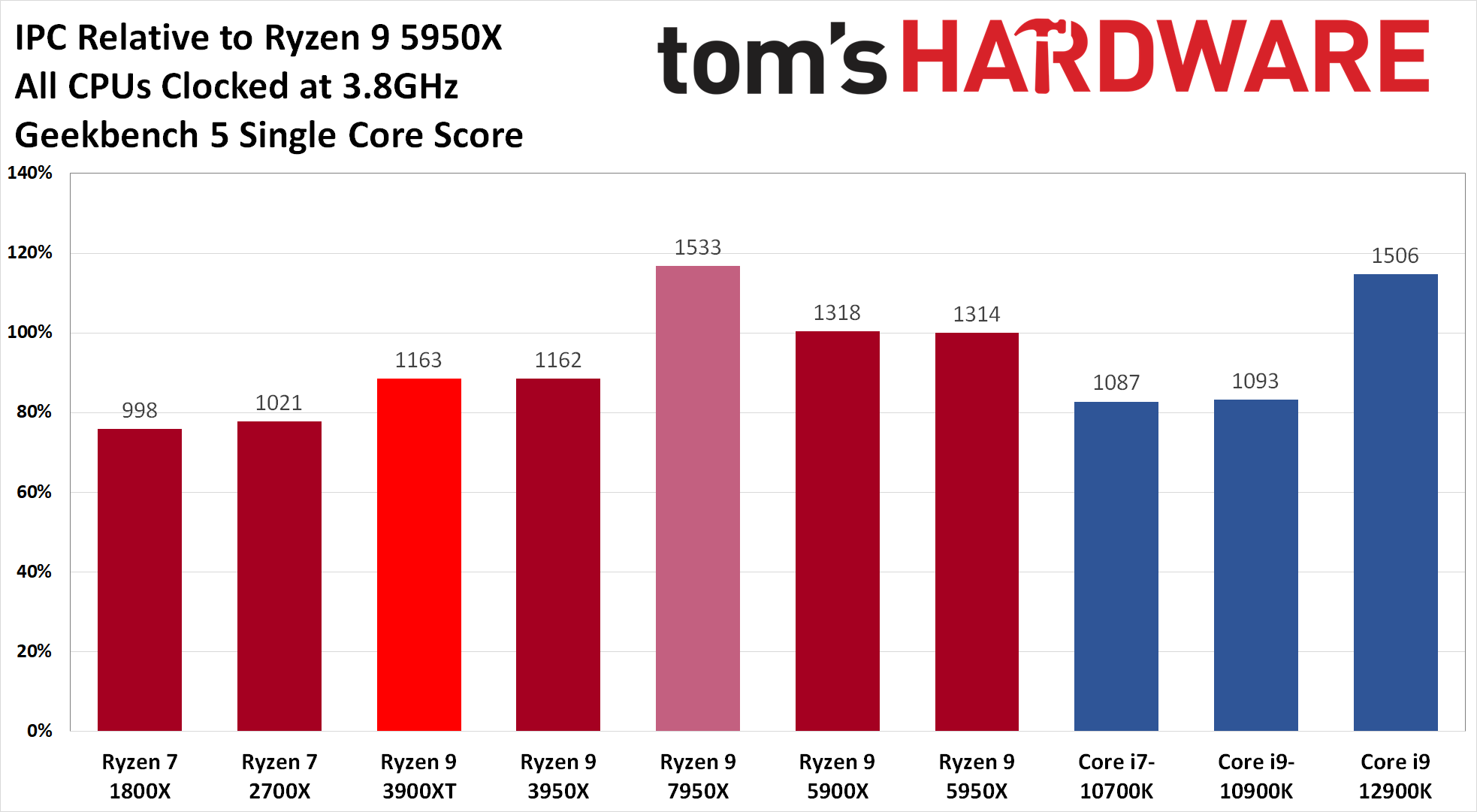




Measuring IPC is tricky, largely because it varies based on the workload. AMD calculated its 13% IPC improvement from 22 different workloads, including gaming, which seems a curious addition due to possible graphics-imposed bottlenecks. AMD also included some multi-threaded workloads. AMD's results show that the IPC improvements vary, with improvements spanning from 39% in wPrime to a 1% improvement in the CPU-z benchmark.
We tested a limited subset of single-threaded workloads to see the clock-for-clock improvements, locking all chips to a static 3.8 GHz all-core clock with the memory dialed into the officially supported transfer rate. As you can see, Zen 4 does deliver solid IPC improvements in a multitude of workloads. The y-cruncher and Geekbench 5 crypto scores experience rather disproportionate gains, but that comes as a result of Zen 4’s support for AVX-512. However, as we saw in the single- and multi-threaded y-cruncher benchmarks, this performance doesn’t scale linearly to higher core loadings.
AMD Zen 4 Ryzen 7000 Power Consumption
AMD worked with TSMC to tune the 5nm process for its design goals, resulting in a specialized 15-layer N5 process node. Unfortunately, we don’t know the specifics of the custom node. However, TSMC’s N5 generally provides 15% more performance at a given power level, or 20% lower power consumption at any given clock rate compared to the 7nm process that AMD used for its previous-gen Ryzen 5000 chips. Paired with the Zen 4 architectural advances and SoC improvements, AMD says Ryzen 7000 delivers up to 40% more performance-per-watt at its standard TDP levels.
| Header Cell - Column 0 | 65W TDP | 105W TDP | 170W TDP |
|---|---|---|---|
| Socket Power (PPT) Watts | 88W | 142W | 230W |
| Peak Current (EDC) Amps | 150A | 170A | 225A |
| Sustained Current (TDC) Amps | 75A | 110A | 160A |
AMD has defined a new 170W TDP range, a new high for the mainstream Ryzen family. AMD has also increased the base TDP for the Ryzen 9 models by 65W and increased Ryzen 5 by 45W. Additionally, the peak power consumption (PPT) for the AM5 socket is now 230W. That's a significant increase over the previous-gen Ryzen 5000's 142W limit.
AMD also increased the TDC and EDC amperage significantly, raising EDC by 60A and 30A for the 65W and 105W TDP ranges, respectively. We see smaller 15A increases to the EDC for both the 65W and 105W TDP tiers.
AMD says that it improved the platform power interface from SVI2 to SVI3, allowing it to move from two variable power rails to three, thus enabling better control of the power delivery to the socket. The SVI3 interface provides continuous and more accurate telemetry for voltage, current, power, and temperature for multiple onboard voltage regulators, while SVI2 didn’t allow monitoring of power and temperature. SVI3 also enables enhanced power states that help save power, like phase shifting (shutting off phases when not needed).

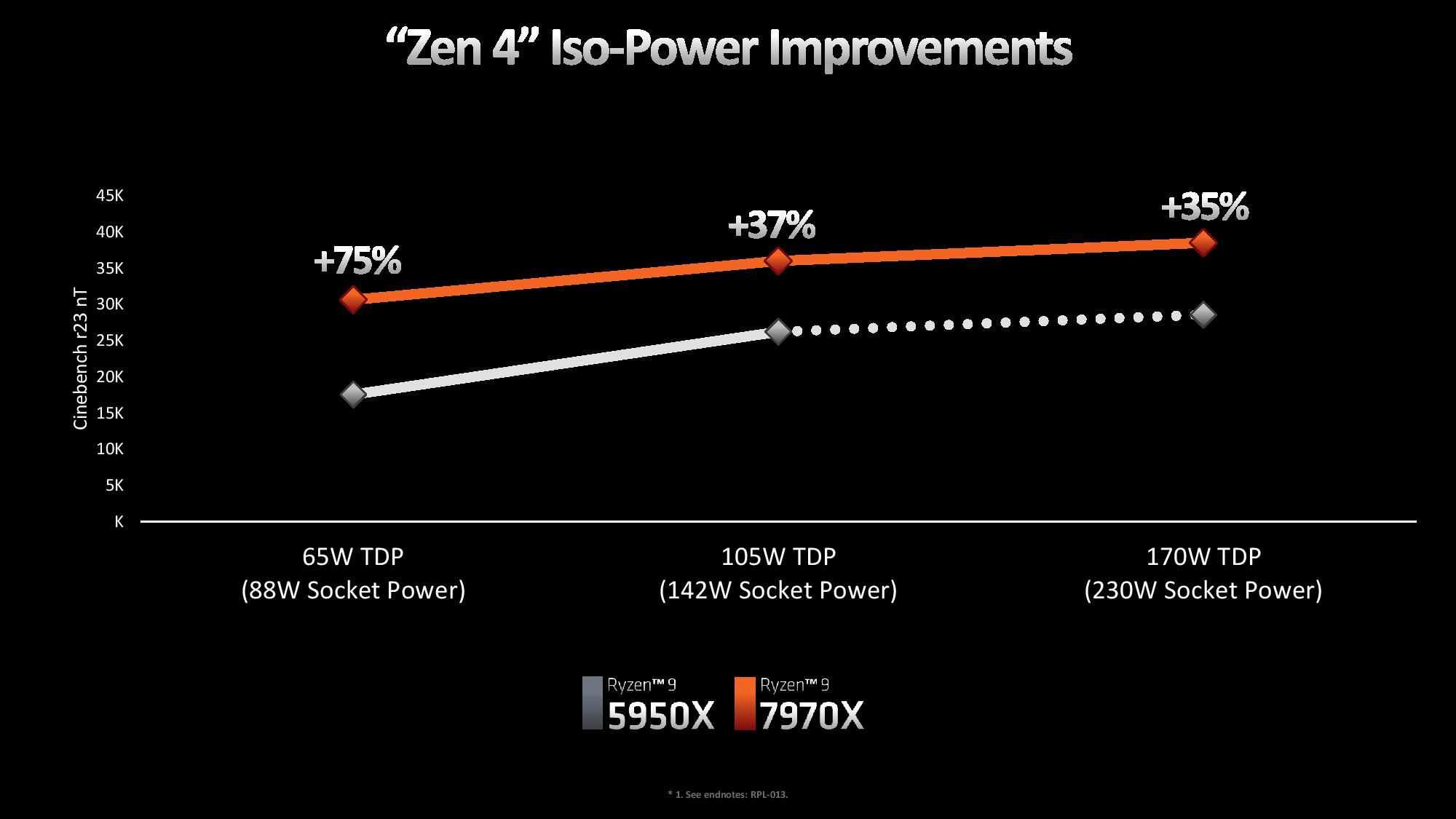
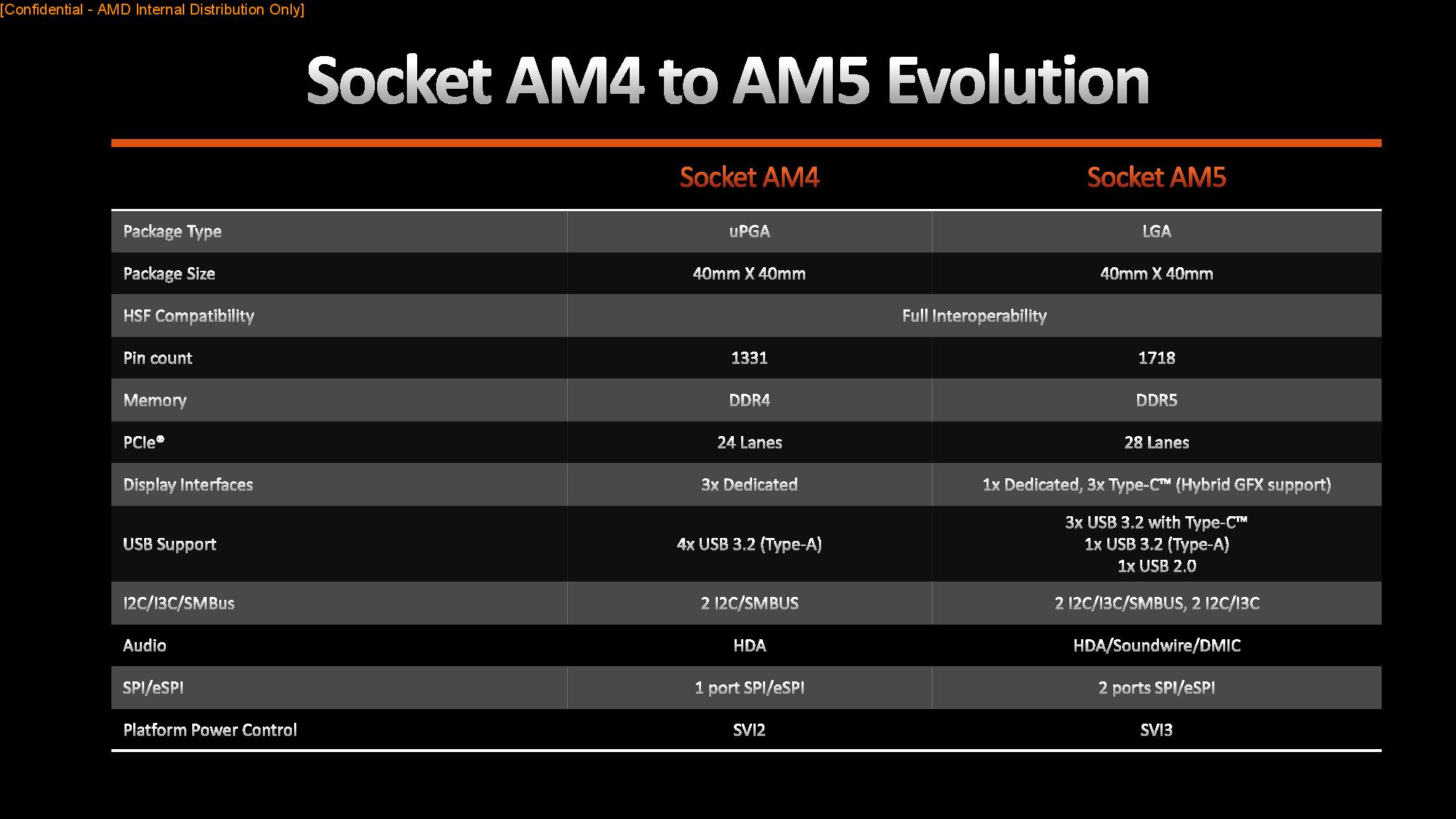

Increasing the TDP and PPT will help AMD deliver more performance, particularly for its higher core-count models, during heavy multi-threaded workloads. In many cases, AMD's previous limit of 142W with the previous-gen AM4 socket held back performance, so the additional 88W of power will be particularly helpful with the newer 12- and 16-core models.
In addition, AMD has specified that it will use the standard TDP and PPT calculations for chips that drop into the AM5 socket — you can simply multiply the TDP by 1.35 to calculate the maximum power consumption of the chip (PPT).




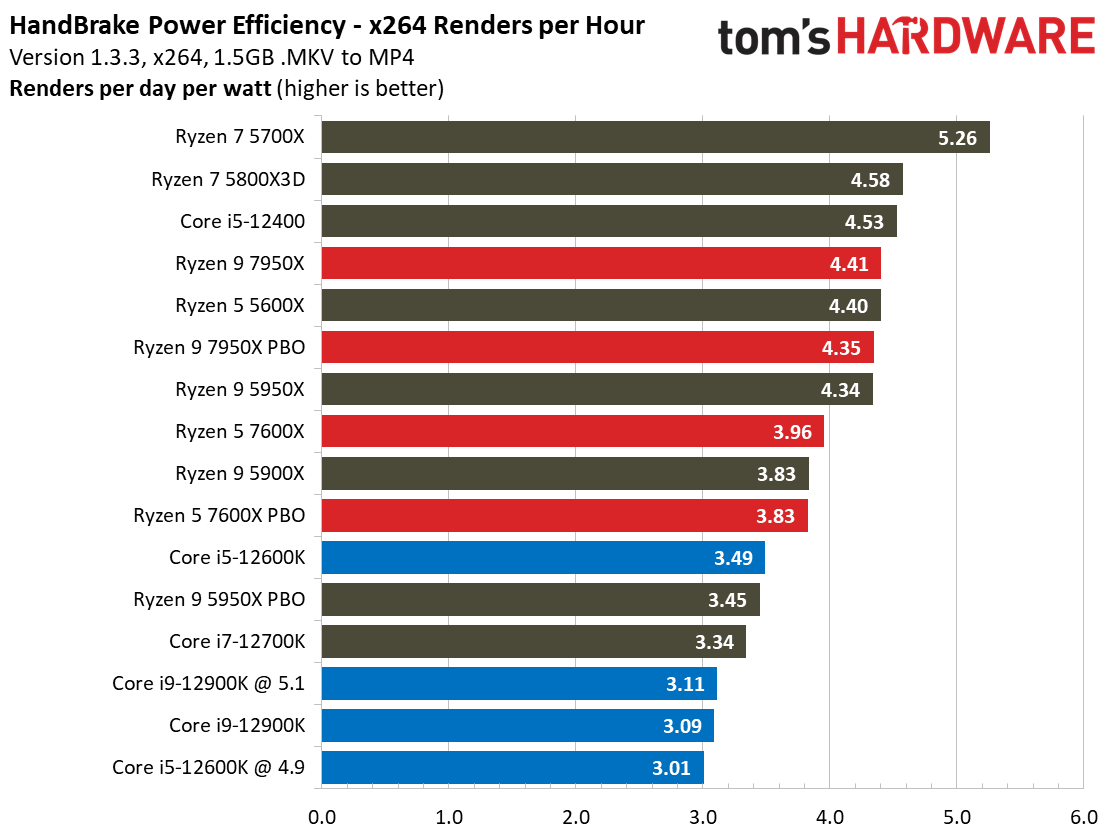


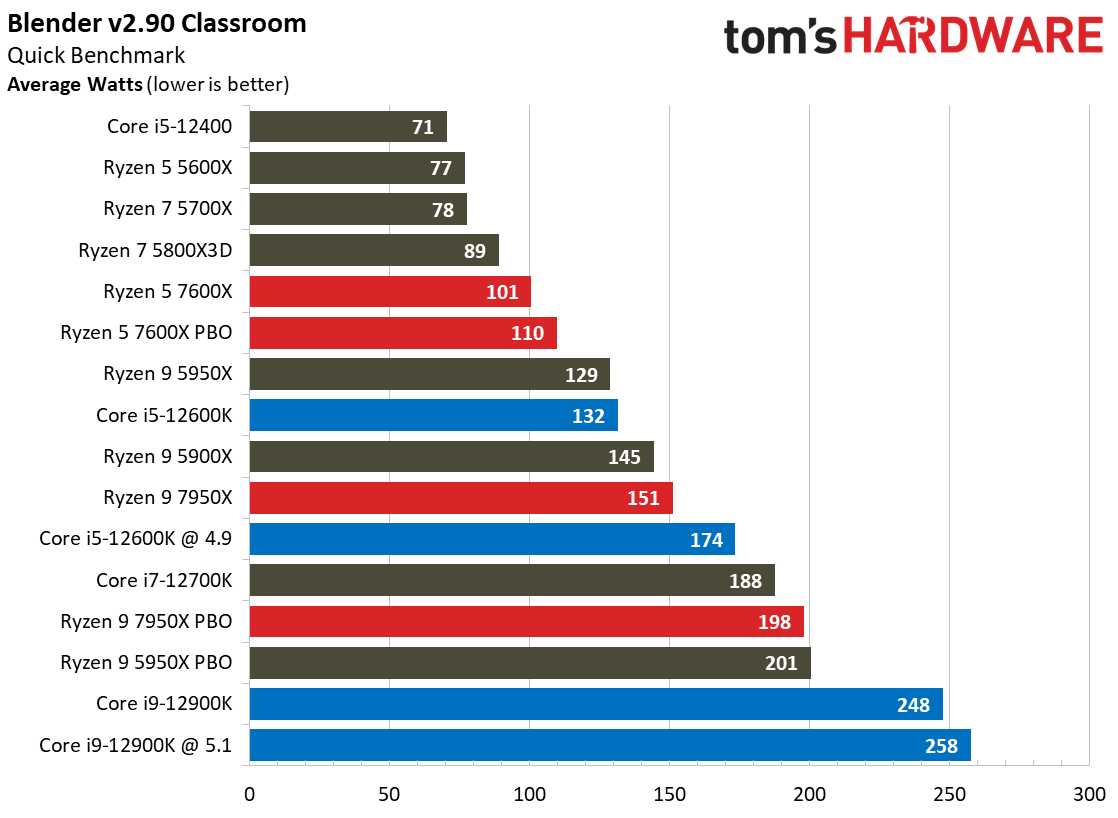

As expected, our power measurements find the Ryzen 7000 chips drawing significantly more power than the previous-gen Ryzen 5000 models, and that’s by design. Despite Ryzen’s gen-on-gen increase in power consumption, Intel’s Alder Lake processors still consume more power while delivering less performance.
The renders-per-day-per-watt charts show that the Ryzen 5 7600X is far more power efficient than the Ryzen 5 5600X in the x264 HandBrake workload, but the stock Ryzen 9 7950X basically matches the prior-gen Ryen 9 5950X. However, as we know from our benchmarks, the 7950X is much faster than the 5950X in this specific workload, which we can see below.
Naturally, we have to view the increased power consumption through the prism of how much performance-per-watt the processor provides, and here AMD says it has made big strides courtesy of the architecture and process node enhancements.
AMD Zen 4 Ryzen 7000 Architecture

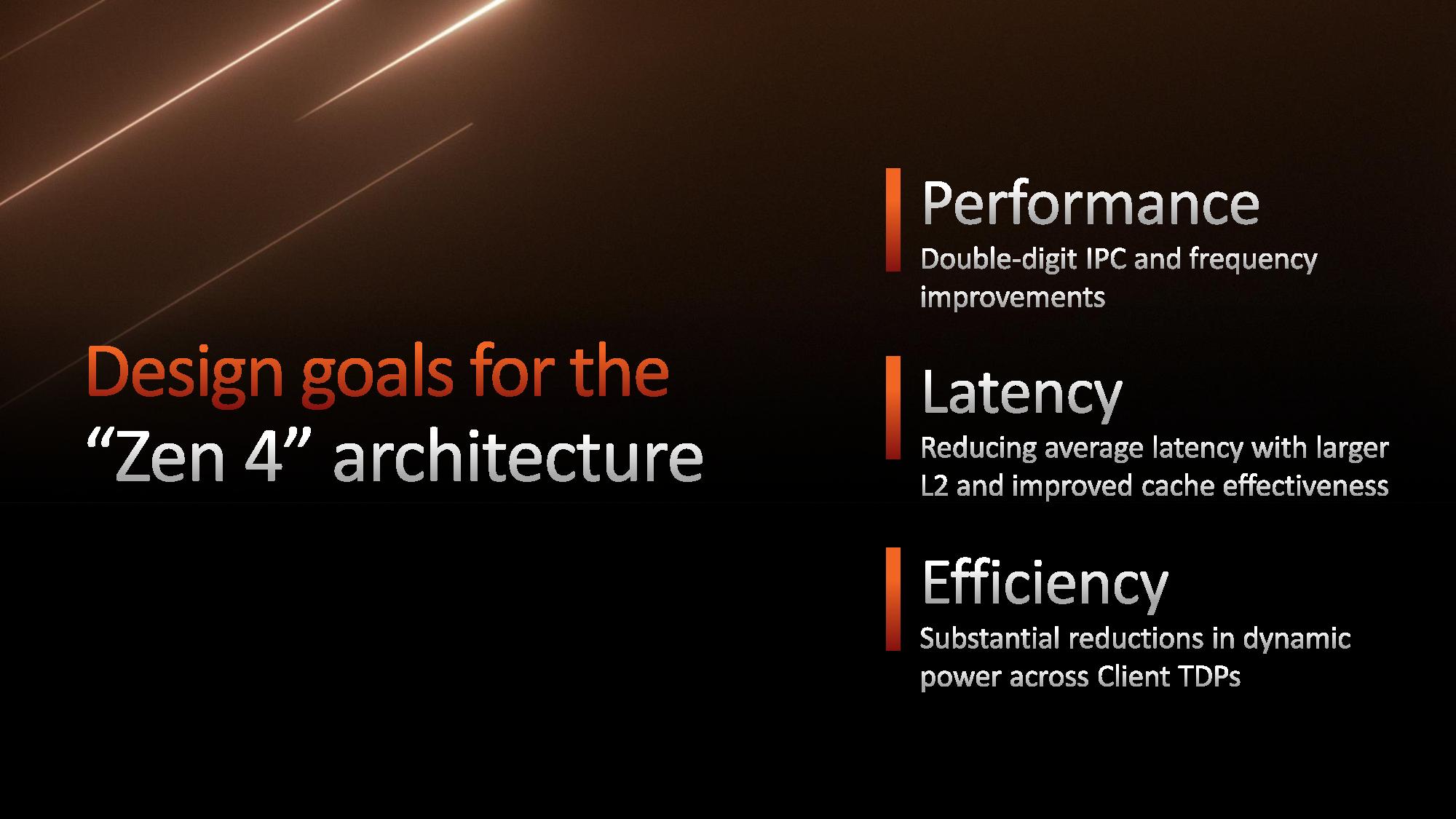



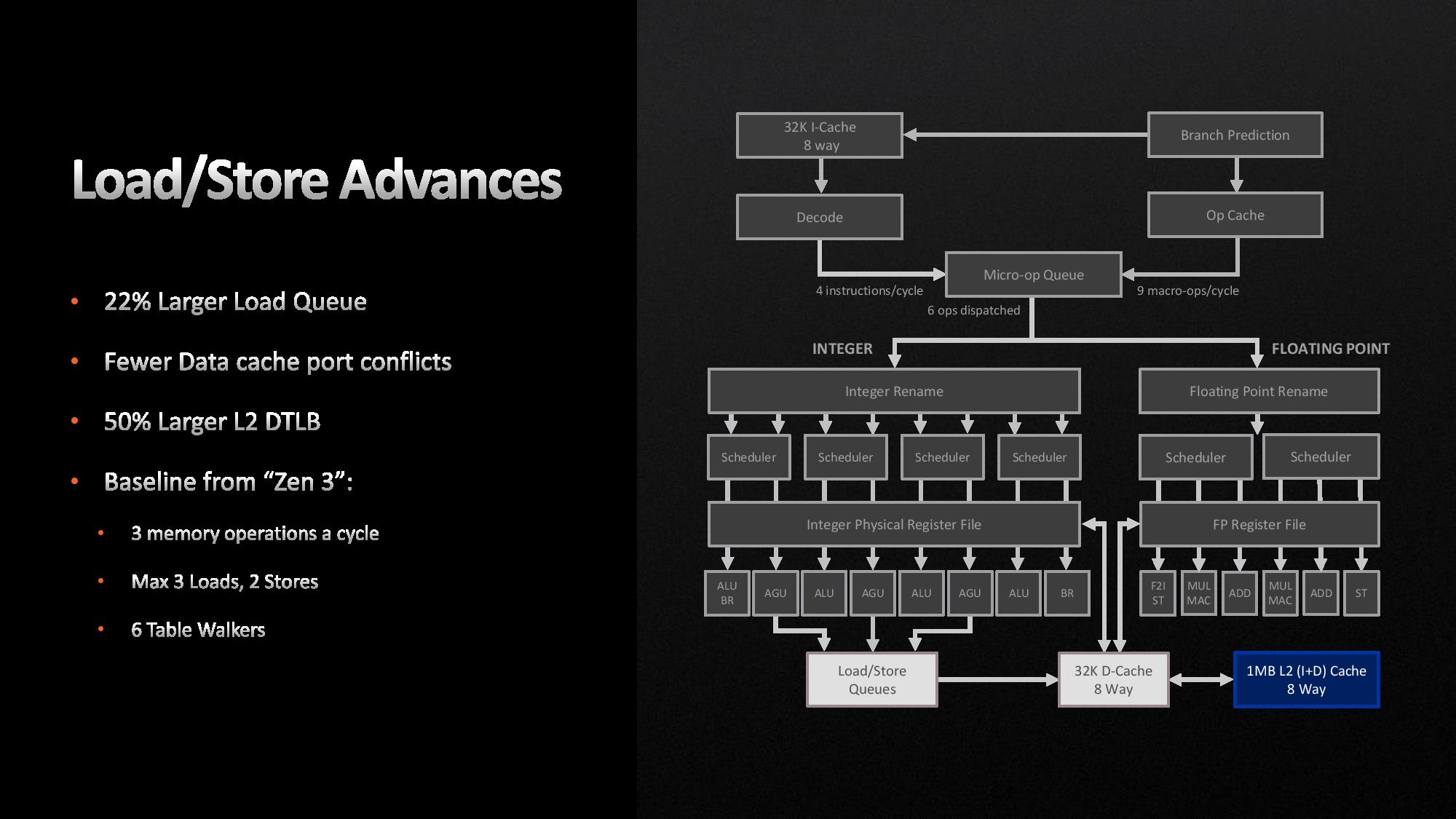

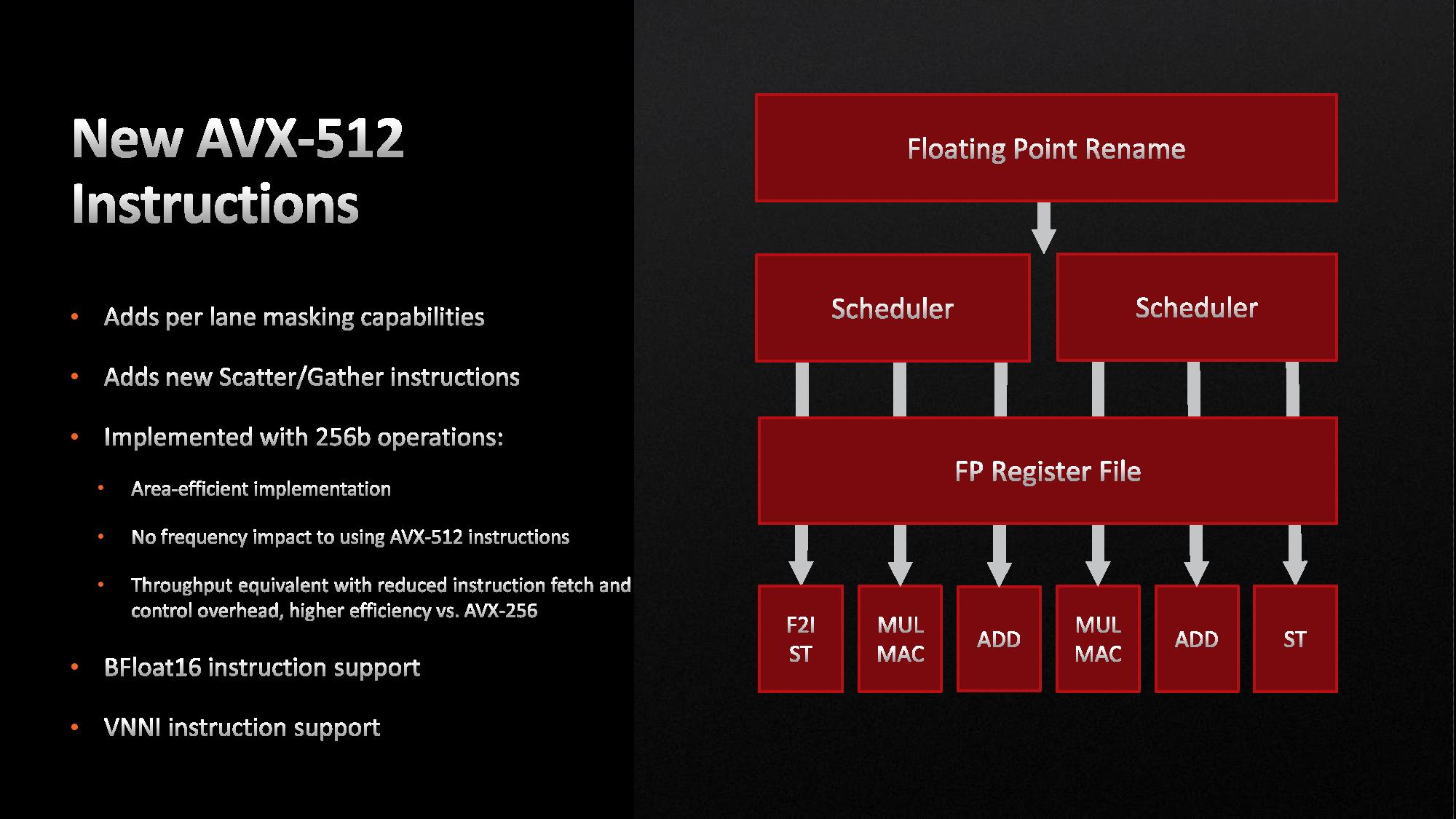



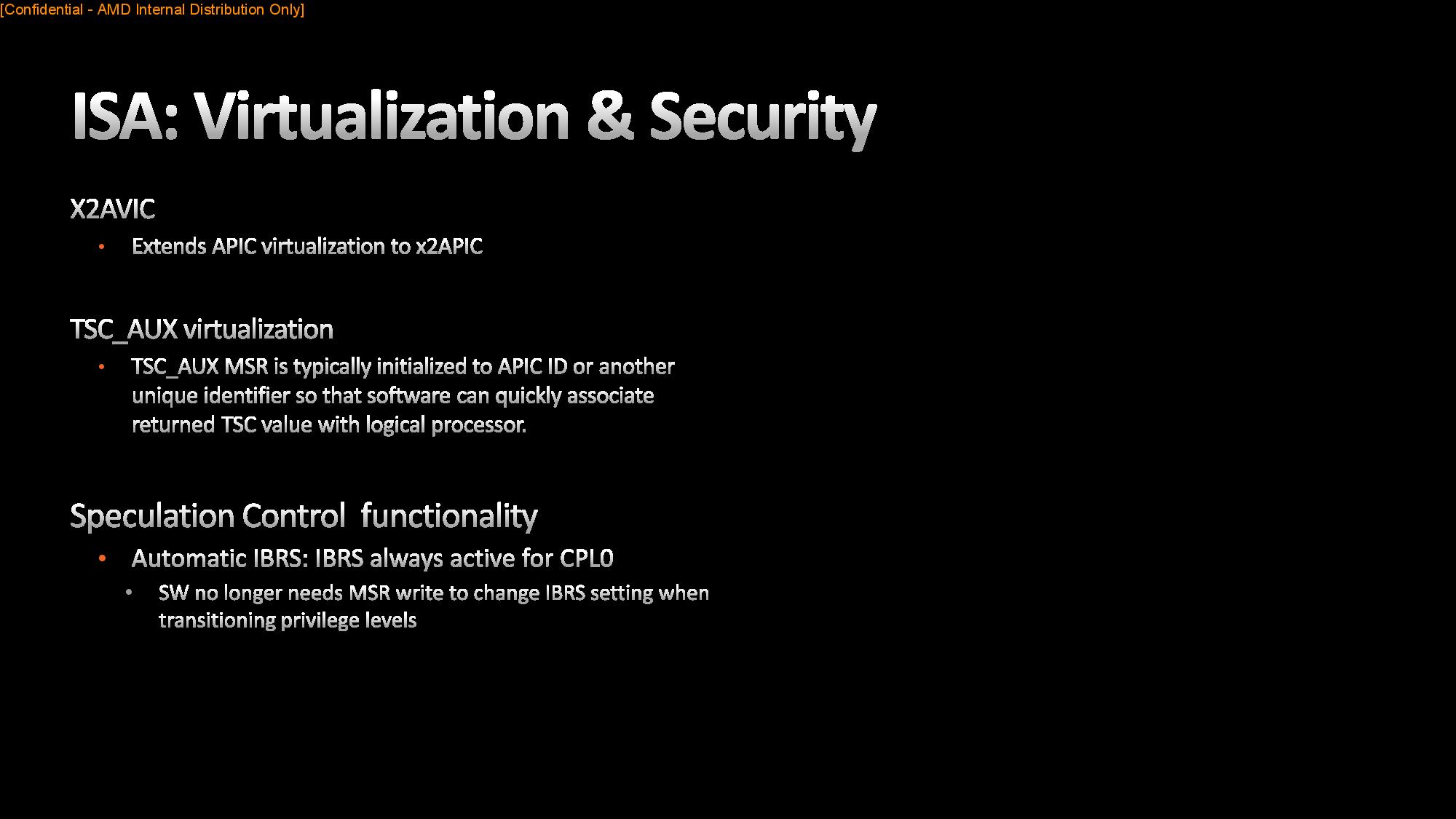


AMD says the Zen 4 architecture is an iterative advance over Zen 3, but Zen 5, which arrives in 2024, will be a ground-up redesign. Zen 4 has plenty of advancements, though. As you can see throughout the album above, AMD made several advances, but widening the front end to better feed the execution units and improving branch prediction account for 60% of the IPC gain. AMD also increased the op-cache by 1.5x, moved to a two-branch-per-cycle prediction, improved the load/store units, and doubled the L2 cache capacity. The increased L2 cache capacity results in an additional 2 cycles of L2 latency and adds 4 cycles to L3 latency. AMD says this increased latency isn’t too detrimental because the increased cache capacity provides higher hit rates that largely offset the penalty.
AMD has enabled support for AVX-512 instructions, giving it a curious advantage over Intel, which pioneered the SIMD instructions but ended up disabling them with Alder Lake. AMD describes its AVX-512 implementation as a 'double-pumped' execution of 256-bit wide instructions. This means that it actually takes two clock cycles to execute an AVX-512 instruction. However, this provides compatibility with AVX-512 and still boosts performance. This approach also saves die area and defrays the frequency and thermal penalties typically associated with Intel's processors when they execute AVX-512 workloads. AMD’s implementation results in lower throughput per clock than Intel's method, but the higher clocks obviously offset at least some of the penalty. AMD says AVX-512 provides a 30% increase in multi-core FP32 workloads over Zen 3 and a 2.5X speedup for multi-core int8 operations. As we saw in our own benchmarks, the approach provides significant performance uplift.
AMD says the net effect of its Zen 4 architectural enhancements is a 13% increase in IPC over Zen 3. AMD also claims to deliver better power efficiency in a much smaller package than Intel's Alder Lake processors. The company compared its Zen 4 core to Intel's Golden Cove to highlight that it is half the size at 3.84mm2, yet wrings out 47% more power efficiency.
With Intel's chips, we've seen larger L2 caches primarily benefit data center workloads. Larger L2 caches generally reduce L3 cache accesses (theoretically by ~40% in this case), which reduces contention on the fabric, thus enabling better scalability and performance in all-core workloads — as opposed to enabling big boosts to single-threaded work. That means there's a chance Zen 4's increased L2 capacity will pay off more handsomely for the EPYC Genoa server chips than it will for most desktop PC applications. But that's not to say that AMD won't extract benefits for other types of work, like gaming and desktop PC applications — any increase in hit rates helps improve IPC.
The die size for the new 6nm I/O die (IOD) is 122mm^2, or roughly the same size as the 124.94mm^2 12nm IOD present on the Ryzen 5000 chips. It has 3.4 billion transistors.
Additionally, the Zen 4 compute die (CCD) measures 70mm^2, which is somewhat smaller than the 83.74mm^2 die on the Ryzen 5000 processor. Given that we're looking at a much denser N5 process for Ryzen 7000 compared to the 7nm process for Ryzen 5000, the smaller die has 6.5 billion transistors for the Zen 4 CCD compared to 4.15B transistors for Zen 3 CCDs (a 36% increase for Zen 4).
| AMD Codenames (all not confirmed) | Core | CCD (Core Compute Die) |
| Zen 2 | Valhalla | Aspen Highlands |
| Zen 3 | Cerebrus | Breckenridge |
| Zen 4 | Persephone | Durango |
| Zen 5 | Nirvana | Eldora |
AMD Zen 4 Ryzen 7000 Processors and AM5 Socket




The top of the Ryzen 7000 package looks busy with a full complement of capacitors spread out across the PCB. This eliminates the need for capacitors that face into the socket, like the large arrays of capacitors we see spread among the LGA pads on Intel's processors. As such, the bottom of the chip is left clear to only house the LGA pad array. (Ryzen 7000 pad image from @ExecuFix - not official from AMD.)
Ryzen's capacitor arrangement necessitates the great-looking heatspreader — the company couldn't put the capacitors under the IHS due to heat issues — but it also likely eliminates any chance of AMD adding a third die to the chip. AMD has said that Zen 4 chips will top out at 16 cores and 32 threads at launch, just like the previous-gen Ryzen 5000 series. AMD has told us that AM5 will be a similarly long-lived socket as we saw with AM4, so it's possible we could see higher core counts in this socket in the future with newer generations of Ryzen.






A motherboard vendor shared a video of a Ryzen 7000 processor being slotted into the new AM5 socket but then removed the video. Luckily, we grabbed some screenshots before they took the video down. This new socket marks a big departure for AMD — the company is moving from its long-lived Pin Grid Array (PGA) AM4 sockets to a Land Grid Array (LGA) AM5 layout. Despite the entirely different LGA1718 socket interface (1718 pins), the AM5 socket will still support AM4 coolers. The AM5 socket measures 40x40mm and the Ryzen 7000 chips adhere to the same length, width, Z-height, package size, and socket keep-out pattern as the previous-gen models, enabling backward support for AM4 coolers. AMD says all but 5% of existing coolers will work without new brackets (which cooler makers typically provide free), and some of the bigger names in cooling, like Noctua, have already announced backward compatibility with the socket.
As an interesting aside, Intel's LGA 1700 socket has a higher pin density than the AM5 socket. That's partially because Intel has a large empty keep-out space in the center of its sockets to accommodate the capacitors on the bottom of the chip. In contrast, AMD has placed all capacitors on top of the PCB, thus allowing it to maximize socket area.
Interestingly, the Ryzen 7000 IHS says the chips were made and diffused in Taiwan, whereas Ryzen 5000 chips were diffused in Taiwan but made in the US.

An image of the underside of Ryzen 7000's integrated heat spreader (IHS), shared to a Facebook group by an unknown poster, has also emerged. We actually learn quite a bit about the chip from the image, such as that AMD will continue to use solder thermal interface material (TIM) with its Zen 4 Ryzen 7000 processors. The IHS also appears quite thick, which helps with thermal dissipation, thus easing cooling requirements.
We can also see the glue at each of the mounting points on the eight 'arms,' which is a departure from AMD's seal-all-around approach with the Ryzen 5000 chips. The two compute dies ride one edge of the heat spreader. As you can see, there isn't room for a third die inside the package unless AMD were to alter the die placements significantly.
Finally, we can clearly see the cutouts that make room for the surface mount devices (SMDs) on the top of the PCB (these are mostly capacitors). These top-facing SMDs will certainly add quite a bit of risk to delidding, but that would have limited appeal anyway, given that AMD uses solder TIM. The design does pose the risk of excess thermal paste squeezing out onto the capacitors, but that won't be a concern with non-conductive thermal pastes. If you use a conductive paste it could be safest to use a sealant, like clear fingernail polish, over the exposed capacitors nearest the heatspreader.
AM5 pic.twitter.com/5TjnTL7u3LJuly 16, 2022
By expanding the above tweet, you can clearly see the alignment key etched into the processor that prevents incorrect installation into the socket. You can also expand the tweet thread to see further images of the socket and Ryzen 7000 processor. We've also seen images of a qualification sample.
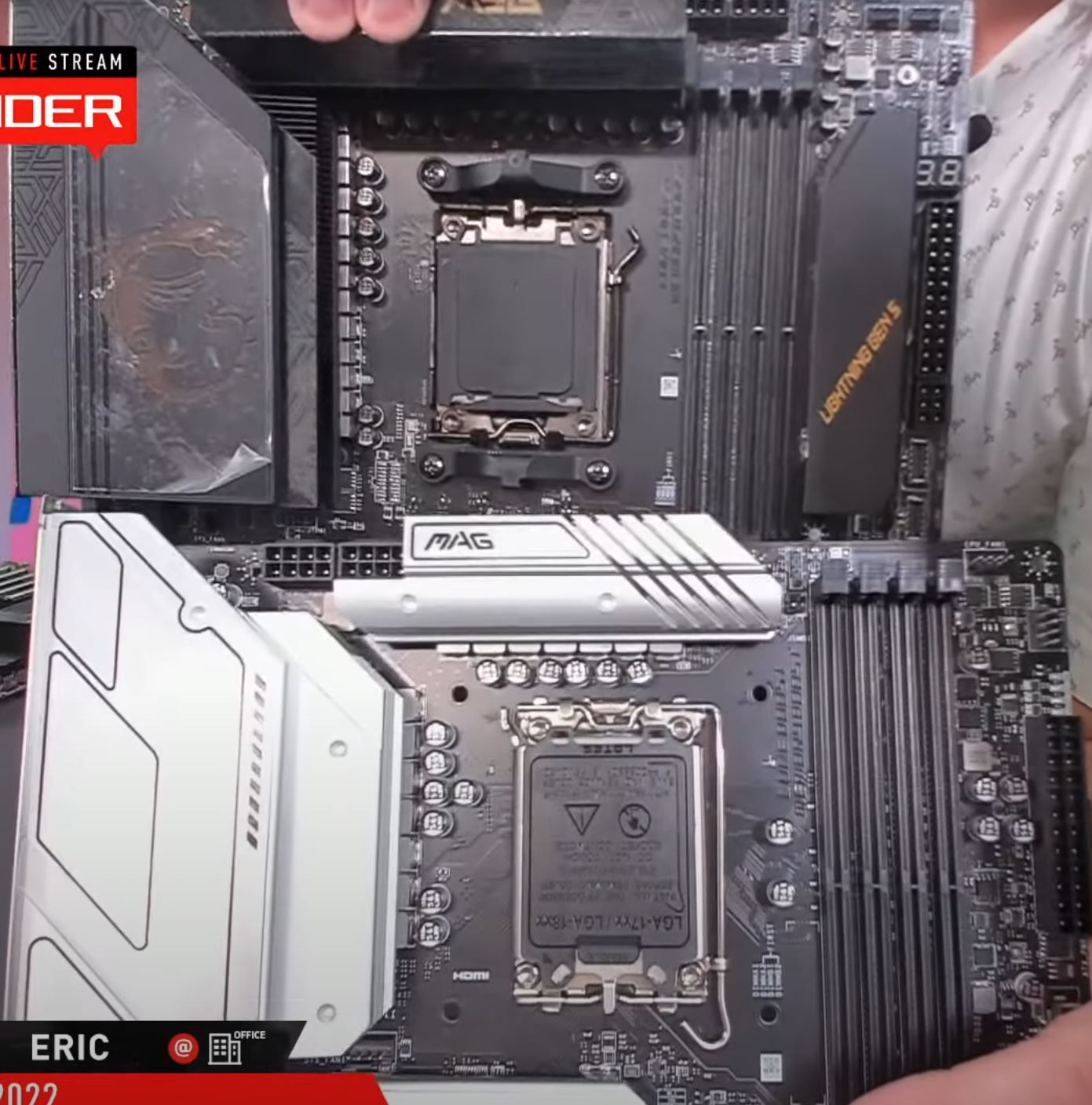
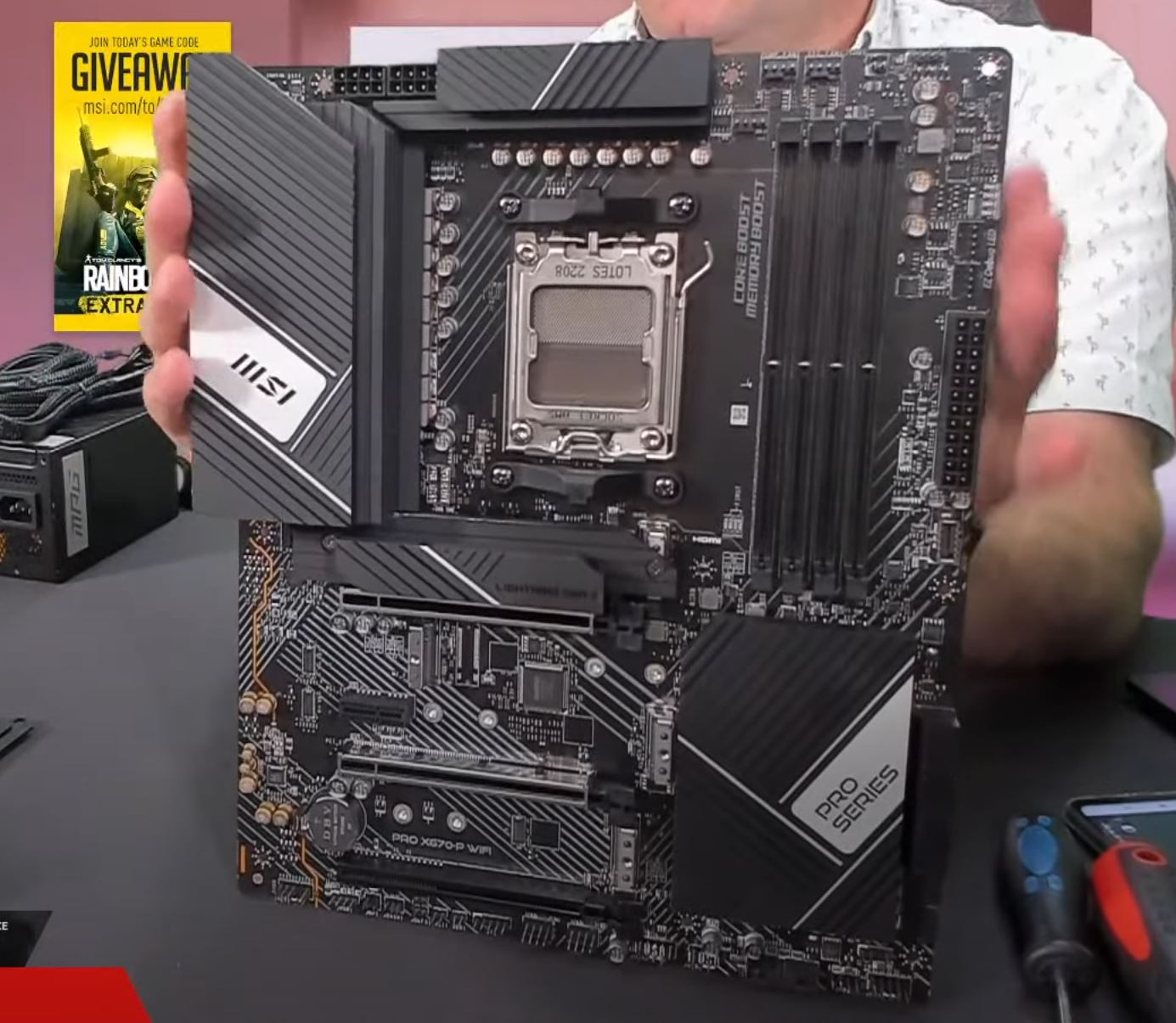
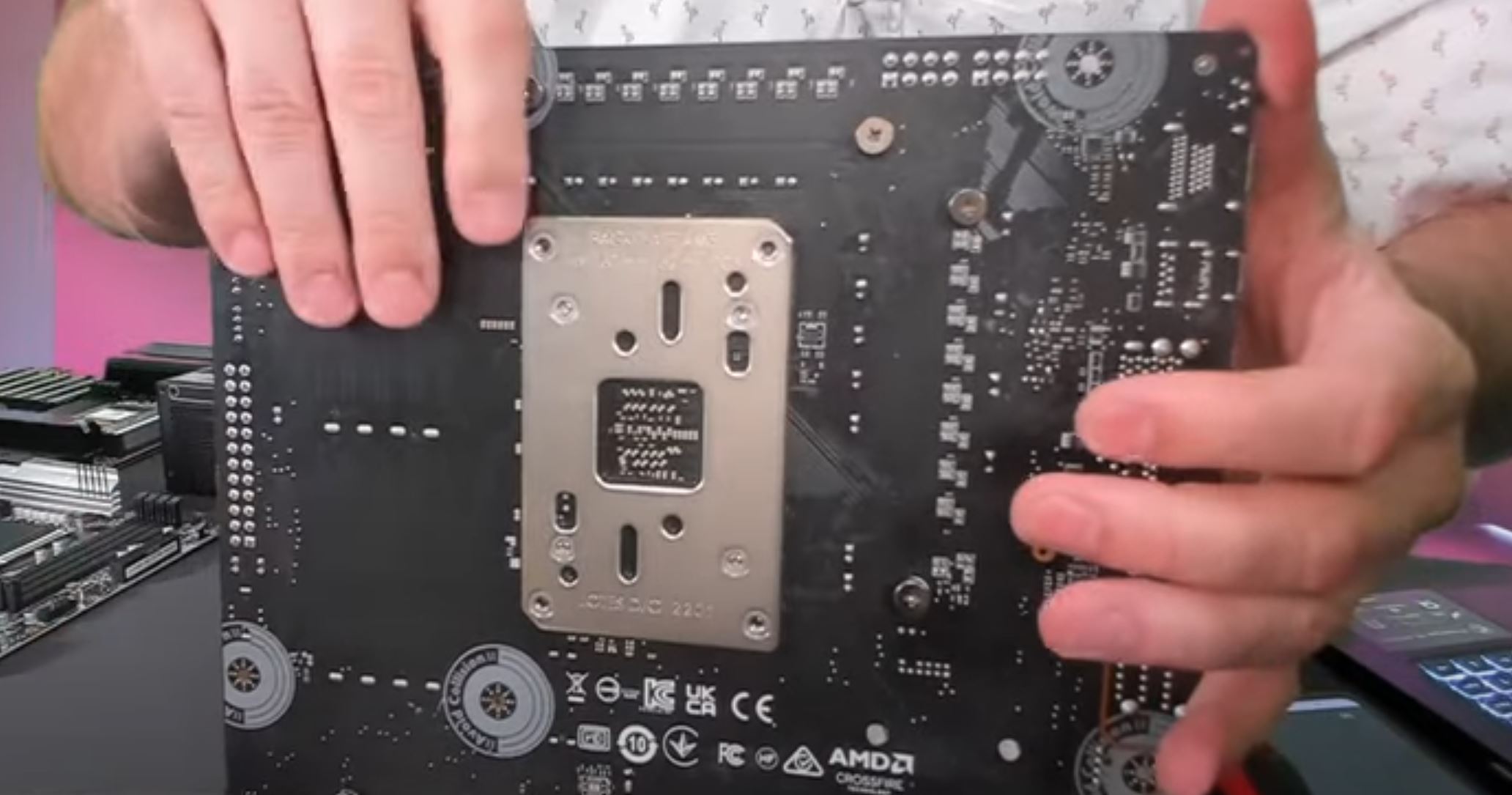
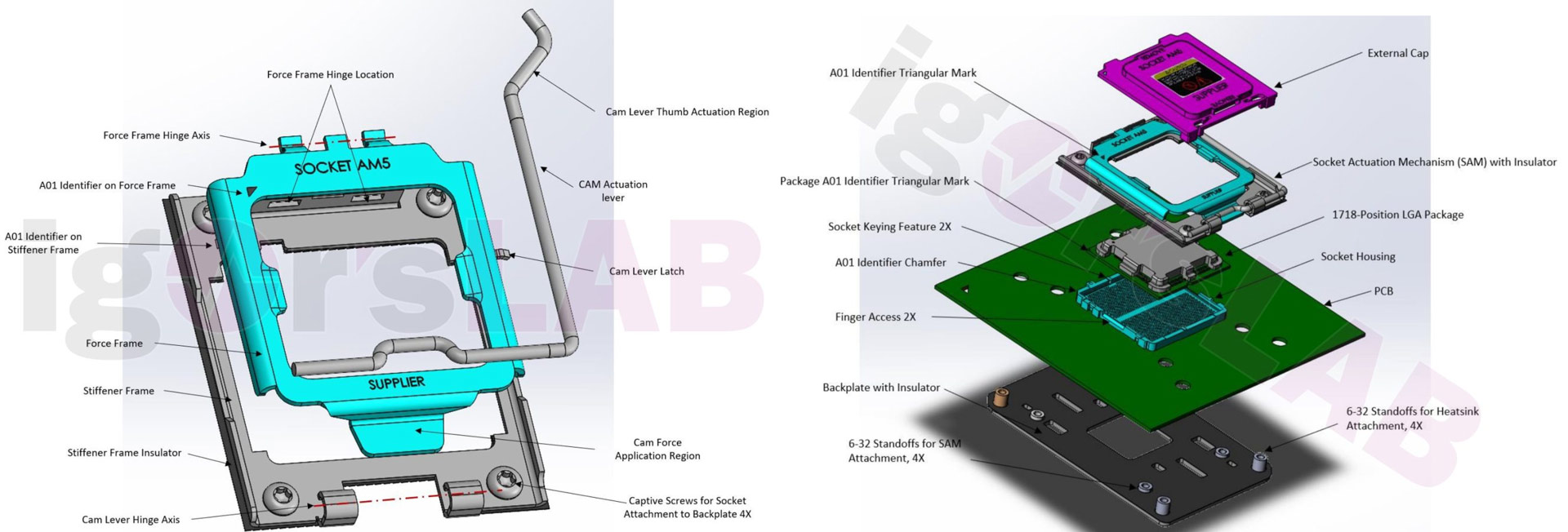


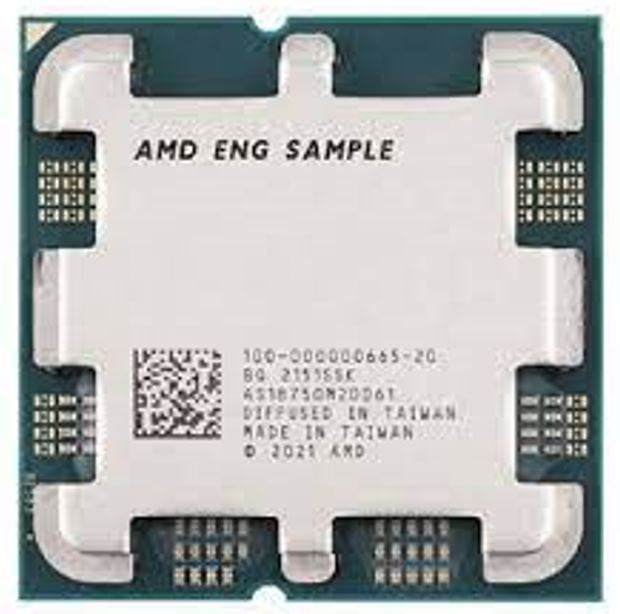
Above you can see the AM5 socket compared to Intel's socket LGA 1700, along with the AM5 backplate and the open socket, all courtesy of an MSI live stream. AM5 will use both Lotes and Foxconn mounting hardware. We also have detailed AM5 diagrams in the above album, courtesy of Igor's Lab.
AMD Zen 4 Ryzen 7000 600-Series with AM5 Socket: X670E Extreme, X670, B650E and B650 Motherboards





AMD's socket AM4 has served for five years across five CPU generations, four architectures, four process nodes, 125+ processors, and 500+ motherboard designs. It all started with the lowly A-Series 'Carrizo' chips that came before even Ryzen so it's time for a new socket, AM5, which also means a refreshed series of motherboards. AMD has now committed to supporting AM5 through 2025+, and it expects the Socket AM4 ecosystem to also live on longer.
The X670 and X670E chipsets will be available at launch, while the newly-announced B650E and the B650 will arrive in October (AMD will showcase the B-Series boards on October 4, 2022). AMD says that motherboard pricing will drop as low as $125, but hasn't clarified if that constitutes pricing for X- or B-series boards.
The Raphael processors will drop into a new AM5 socket that supports the PCIe 5.0 and DDR5 interfaces, matching Alder Lake on the connectivity front. The Socket AM5 motherboards will expose up to 24 lanes of PCIe 5.0 to the user, the most PCIe 5.0 lanes direct from the socket in the industry, and leverage an additional four lanes of PCIe 5.0 to connect to the chipset (less expensive motherboards can use a PCIe 4.0 connection to the chipset, AMD recently qualified the interface for Ryzen 7000). AMD also appears to support PCIe lane bifurcation to carve a connection into different allocations (turning an x8 slot into two x4 interfaces, for instance, which is very helpful for SSDs). Intel's Alder Lake doesn't support PCIe lane bifurcation, and it isn't clear if Raptor Lake will. Additionally, all of AMD's new 600-series chipsets are fanless.
The chipset also supports up to 14 SuperSpeed USB ports up to 20Gbps and Type-C, along with support for Wi-Fi 6E with DBS and BlueTooth LE 5.2. AMD also recently added support for USB 4 to its Ryzen platform, so that'll be supported, too. AMD hasn't specified, but the Wi-Fi 6E support comes as a discrete chip from the company's initiative with MediaTek (some MSI boards, for instance, use the RZ616). We also expect to see other discrete chips for support for 40 Gbps USB 4.0 Type-C ports, which we've already seen on some flagship AM5 motherboards — it's clear that AMD has vastly improved its connectivity options. The Ryzen 7000 chips also feature the SVI3 power infrastructure that supports more power phases from the motherboard and enables faster voltage response.
The X670E 'Extreme' chipset will support PCIe 5.0 for two graphics slots and one M.2 NVMe SSD port. This chipset is designed for motherboards that aim for extreme overclockability and connectivity, carving out a new tier above AMD's standard lineup. X670E serves as the premium tier, and while we've seen a few affordable models listed at etailers for under $300, we've also seen fully-equipped boards with incredibly high MSRPs that peak at $800 for 'standard' models.
The X670 chipset powers the 'standard' high end motherboards and will come in multiple flavors with varying PCIe support. The M.2 port will support the PCIe 5.0 interface, but the first graphics slot can support either a peak of PCIe 4.0 or PCIe 5.0, which will vary by the motherboard. This offers a lower-cost sub-tier of PCIe 4.0 X670 motherboards, allowing enthusiasts to avoid paying the extra costs associated with PCIe 5.0.
The B650 chipset will support PCIe 5.0 for a single NVMe port, but only PCIe 4.0 for the graphics slot. This chipset also supports overclocking, but as per usual, you won't find as robust of power accommodations as you will with the more expensive boards. (To learn more about overclocking, head to our How to Overclock a CPU guide.)
The B650E motherboards will provide PCIe 5.0 to both the M.2 and GPU slots, while the standard B650 will only have 5.0 to the M.2 slot, and PCIe 4.0 everywhere else. AMD says that both types of B-series boards will offer the same performance and overclockability - the only difference resides in the PCIe connectivity.
Socket AM5 motherboards support up to four display outs via HDMI 2.1 Fixed Rate Link (FRL) and Displayport 1.4 High Bit Rate 3 (HBR3) outputs, powered by the RDNA 2 graphics engine onboard the 6nm I/O die in the Ryzen 7000 processors.
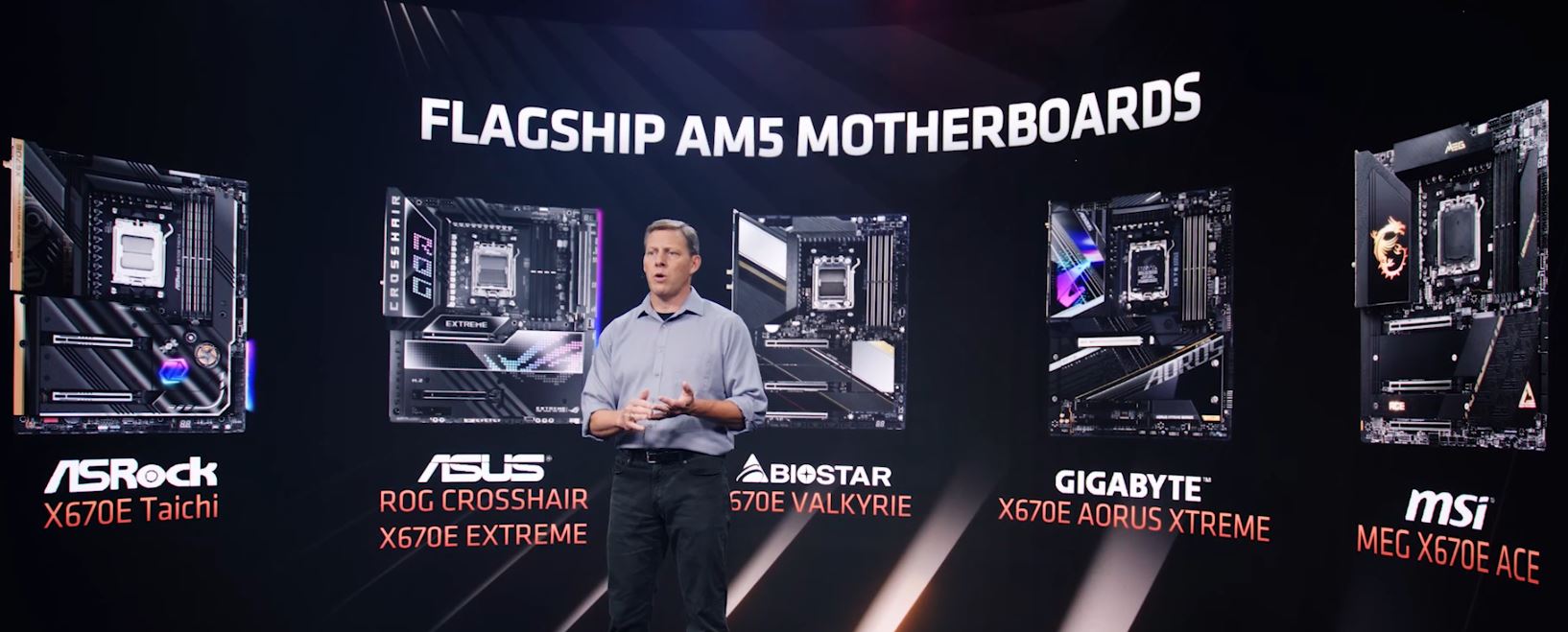

AMD initially unveiled five of the upcoming flagship X670E motherboards, with offerings from MSI, ASRock, ASUS, Gigabyte, and Biostar. The company later had representatives from all of the major motherboard makers present their full lineups during a webinar. You can head here for the full rundown, including specifications and pictures for a constellation of AMD AM5 motherboards, and take a look at new features, like latchless M.2 ports and PCIe slots on Gigabyte's motherboards here. In fact, Gigabyte is already seeding motherboards to overclockers. Asus and MSI have both shown their full roster of X670E and X670P motherboards, too.
AMD hasn't clarified its dual-chipset alignment yet, but the pictures of the motherboards have confirmed many of the details we previously uncovered. According to our sources, AMD's mainstream B650 platform will come with a single chipset chip that connects to the Ryzen 7000 CPU via a PCIe 4.0 x4 connection. However, documents we've seen say that a PCIe 5.0 connection is available on some AM5 processors.
Meanwhile, the enthusiast X670 platform employs two of these ASMedia chips (our sources confirm the chips are identical, not a north/southbridge-type arrangement), effectively doubling these connectivity options. Furthermore, these chipsets are daisy-chained together. This stands in contrast to AMD's approach with the current 500-series motherboards, which use different chips for the X- and B-series motherboards. The new approach will obviously provide cost and design flexibility advantages.
ASUS PCH vs MSI PCH🤔 pic.twitter.com/UP4BzhuDWWMay 28, 2022
Another report about the 600-series chipset (codenamed Promontory 21 - PROM21) has backed up our findings and provided more insights into the power- and cost-saving features of the 600-series chipset design. The chipset is estimated at 40mm^2 (19x19mm). If you expand the tweet above, you can see another interesting caveat of AMD's new chiplet-based chipset approach — motherboard vendors can place the chipsets in varying orientations. We've also seen another implementation with what appears to be a PCIe switch placed in between two chipsets, possibly for fanout connections, so there is a possibility that we'll see a number of different techniques.
Finally, AMD has confirmed that the AM5 socket will only support DDR5 memory. The company says that DDR5 provides the extra performance to justify the cost, but we'll have to watch pricing closely. As we've reported, DDR5 continues to be more expensive than DDR4, largely because DDR5 marks the first generation of mainstream memory with onboard power management ICs (PMICs) and VRMs. Unfortunately, those have been in constant shortage due to the pandemic, but luckily, DDR5 pricing has fallen as PMIC and VRM supply improves. Unfortunately, DDR5 is still more expensive than comparable DDR4 kits.
However, DDR5's more complex power circuitry and design mean that these modules will continue to command a premium over DDR4. DDR5 also has in-built ECC mechanisms for data at rest, which requires additional dies to provide the same memory capacity as DDR4. This means DDR5 will remain more expensive than DDR4, regardless of supply.
We've also seen audio driver code submitted to Linux to enable the audio co-processor (ACP) present in the chips. This patch has come somewhat late, so there may be no out-of-the-box audio support for Ryzen 7000 chips in Linux when the chips initially come to market, though that will soon be rectified.
AMD Zen 4 Ryzen 7000 Pricing
| Row 0 - Cell 0 | Price | Cores / Threads (P+E) | Base / Boost Clock (GHz) | Cache (L2/L3) | TDP / PBP / MTP | Memory |
| Ryzen 9 7950X | $699 | 16 / 32 | 4.5 / 5.7 | 80MB (16+64) | 170W / 230W | DDR5-5200 |
| Ryzen 9 5950X | $546 ($799) | 16 / 32 | 3.4 / 4.9 | 74MB (8+64) | 105W | DDR4-3200 |
| Ryzen 9 7900X | $549 | 12 / 24 | 4.7 / 5.6 | 76MB (12+64) | 170W / 230W | DDR5-5200 |
| Ryzen 9 5900X | $398 ($549) | 12 / 24 | 3.7 / 4.8 | 70MB (6+64) | 105W | DDR4-3200 |
| Ryzen 7 7700X | $399 | 8 / 16 | 4.5 / 5.4 | 40MB (8+32) | 105W / ? | DDR5-5200 |
| Ryzen 7 5700X | $268 ($299) | 8 / 16 | 4.6 | 36 (4+32) | 105W | DDR4-3200 |
| Ryzen 5 7600X | $299 | 6 / 12 | 4.7 / 5.3 | 38MB (6+32) | 105W / ? | DDR5-5200 |
| Ryzen 7 5600X | $199 ($299) | 6 / 12 | 3.7 / 4.6 | 35MB (3+32) | 65W | DDR4-3200 |
AMD's pricing is great for the highest-end 16-core Ryzen 9 7950X, but the Ryzen 7 7700X pricing seems steep with a $100 upcharge. Additionally, the continued high pricing for the entry-level model might be a sticking point with enthusiasts. That said, Intel has also recently announced that it will increase its chip pricing due to supply chain disruptions and other factors, so we won’t know the full pricing story until Intel launches Raptor Lake.
The price of the chip you buy isn't always all that matters, though: The X670 and B650 AM5 platforms support only DDR5 memory, which has pricing implications for platforms built around AMD's upcoming Zen 4 processors. That means Intel's Raptor Lake will likely have a platform pricing advantage with readily-available DDR4 platforms, which could pay off in the mid-range and low end of the product stack. AMD has a counter with less-expensive PCIe 4.0-only X670 motherboards, but we'll have to see how that pans out when those boards come to market.
We asked AMD about the memory pricing situation, and the company tells us that it expects supply and pricing to improve through the end of the year, and says that the memory vendors are working to reduce pricing. AMD said we could even potentially see pricing crossover for DDR4 and DDR5 occur in the middle of 2023. It is noteworthy that the latest market projections do point to a looming memory supply glut due to the recent unexpected decline in PC demand, which should naturally help pricing as well.
All these factors mean you might have to pony up some extra cash compared to competing Intel Raptor Lake platforms, at least with the inaugural Zen 4 'Raphael' Ryzen 7000 chips for Socket AM5. As a result, much like we saw with AMD's high-priced debut for the Ryzen 5000 processors (AMD just finally released lower-cost Zen 3 chips a year and a half later), you can expect to pay a premium for AMD's first Ryzen 7000 platforms when they arrive later this year.
There is an open question, though: Will AMD bring Zen 4 designs to the older AM4 motherboards? We've seen no concrete indications that this will happen in the near future, and it certainly wouldn't make sense until after the full gamut of AM5 Ryzen 7000 chips are released — as a business, it would be a poor decision to undercut your premium products before they're even launched. Will Zen 4 Ryzen 7000 models for AM4 motherboards come later? Time will tell.
We won't have to wait long to see how official pricing stacks up — the 5nm Zen 4 Raphael Ryzen 7000 chips and the accompanying 600-series 'X' chipsets are due to launch on September 27. We're sure to learn much more then, so check back for updates, which we'll add to this article regularly.
- MORE: Best CPUs for Gaming
- MORE: CPU Benchmark Hierarchy
- MORE: AMD vs Intel
- MORE: How to Overclock a CPU
- MORE: How to check CPU Temperature

Paul Alcorn is the Editor-in-Chief for Tom's Hardware US. He also writes news and reviews on CPUs, storage, and enterprise hardware.
-
domih Thank you for this summary article.Reply
My hope as a 3960X user: INTEL will eventually be able to put more than 8 performance cores in one package and be competitive again in HEDT so that AMD feels the need to release a non-PRO version of a Threadripper 7000 series. I need the cores, the PCIe lanes and the memory channels :) -
-Fran- Nice summary.Reply
Let's keep being cautiously optimistic AMD will put the pressure back on Intel, so Intel responds in kind and we all benefit.
Regards. -
Alvar "Miles" Udell The question is if Socket AM5 will be able to attract Socket AM4 users, and I don't think it will. Let's say it's on average 25% faster per thread than the Ryzen 5000 series. The cost of a new motherboard and RAM in addition to the CPU makes that 25% cost an awful lot. Even a Zen 2 or Zen 1 user can drop in a Zen 3 CPU into their existing setup for a large to enormous performance gain for a relatively small price.Reply
Also assuming that AMD is going to attempt to keep the same pace as Intel, the next 3 or 4 years should bring relatively decent to large increases in performance and efficiency across all segments each year, and the last thing most people want is to buy in at the start only to see each generation bring a large performance increase, as those of us who were Socket AM4 early adopters saw.
Combine this with increasing GPU supply and more people finally being able to see what their existing Socket AM4 setup can actually do, and I predict quite sluggish sales of AM5 systems. -
kanewolf Reply
Depends on the motherboard. My 300 series motherboard doesn't support 5xxx series CPUs. So I would have to swap motherboards. That would require a Windows install. I will pay for a 7xxx CPU. I can probably drop to a 7600 from the 1700 I have now.Alvar Miles Udell said:Even a Zen 2 or Zen 1 user can drop in a Zen 3 CPU into their existing setup -
MASOUTH people in here talking about IPC and sockets and I'm just trying to decide if I want to ceiling or wall mount that standard 2800mm AIO ;)Reply -
JWNoctis Maybe someone could get that Agner guy a sample ASAP or at least make use of the same methodology, as soon as it comes out.Reply
That AVX-512 implementation is going to be interesting, considering Intel had just dropped them from their client-oriented lineup. Some solid numbers for IPC would also be nice. -
wifiburger "The five fives: DDR5, PCIe 5.0, 5nm, AM5, and 5.5 GHz+ "Reply
lol, someone is excited about tech buzzwords
DDR5a big meh !, people will still buy / stick with DDR4 platform and by the time there's mass production / price drop we'll be on DDR6
PCIe 5.0
Great ! except this is on a consumer platform where it's not needed & no products
5.5ghz+
400mhz boost would be impressive if it wasn't for people having to spend 800$ on new mobo+ddr5 -
alceryes ReplyAlvar Miles Udell said:The question is if Socket AM5 will be able to attract Socket AM4 users, and I don't think it will. Let's say it's on average 25% faster per thread than the Ryzen 5000 series. The cost of a new motherboard and RAM in addition to the CPU makes that 25% cost an awful lot. Even a Zen 2 or Zen 1 user can drop in a Zen 3 CPU into their existing setup for a large to enormous performance gain for a relatively small price.
Also assuming that AMD is going to attempt to keep the same pace as Intel, the next 3 or 4 years should bring relatively decent to large increases in performance and efficiency across all segments each year, and the last thing most people want is to buy in at the start only to see each generation bring a large performance increase, as those of us who were Socket AM4 early adopters saw.
Combine this with increasing GPU supply and more people finally being able to see what their existing Socket AM4 setup can actually do, and I predict quite sluggish sales of AM5 systems.
You're probably right, if for no other reason than the bearish economy shift we've slid into. We knew this was coming, though.
AM4 will be 6 years old when AM5 launches. I consider the fact that we've been able to use the same platform for Zen, Zen +, Zen 2, and Zen 3 CPUs a testament to AMD's willingness to stay with the same platform, in part to ease builder's costs. Barring some major apocalypse, technology is always moving forward. The next 3-4 years always* brings major performance improvements in CPUs. If you play the 'wait and see' game, you'll just be constantly waiting.
I will definitely be upgrading to AM5. My Z370/i9-9900k has served me well but it's time for an upgrade. AM5 will bring major improvements and, with AMD saying that AM5 will be as long-lived as AM4, I don't mind spending some $$$ for something that will last. I'm not sure yet if I'll go full tilt though. I may go with a top end motherboard and middling CPU, for starters.
*We're gonna forget about AMD's Bulldozer and Intel's Pentium 4 releases. ;) -
deksman Replydomih said:Thank you for this summary article.
My hope as a 3960X user: INTEL will eventually be able to put more than 8 performance cores in one package and be competitive again in HEDT so that AMD feels the need to release a non-PRO version of a Threadripper 7000 series. I need the cores, the PCIe lanes and the memory channels :)
There is a non-PRO Threadripper 3990x with 64 cores and 128 threads, but its limited to supporting 265GB RAM (which isn't exactly a small amount), however the price tag behind this beast is pretty high.
More core CPU's are out there... problem is, they are WAY too expensive for the average user or even aspiring 3d artists (where hardware like this would definitely come in hand)... I'd prefer they drop the price tags to something that's actually affordable. -
JarredWaltonGPU Reply
You know Paul likes to use a custom 3x3 140mm liquid radiator for his CPU testbed. Or is it a 4x4 140mm cooler now, @PaulAlcorn?MASOUTH said:people in here talking about IPC and sockets and I'm just trying to decide if I want to ceiling or wall mount that standard 2800mm AIO ;)
